Between the 16th and 20th of June 2024, the cycling club Cykelintresset hosted the third edition of Midnight Sun Randonnée. Written reports, photos and videos from cyclists who participated in the event will be added to this page during 2024.
Linked reports
Janek Doroszkiewicz
Social Media & YouTube
Lisa Charlebois
Damian Pałyska
Chris Beauchamp
The Midnight Sun Randonnée (MSR) 2024 looked to be a very beautiful ride when I first investigated this ride in January 2024. The Randonnée was billed as 1200 km ride to the Artic circle and back. The ride started in Umea, Sweden and went out to Mo I Rana, Norway before heading north into the Artic circle. The Randonnée would take place beneath the Midnight Sun – as Sun that did not set in the Artic Circle. 24 hours of daylight, no lights needed! The ride had no drop bags. The riders had to be completely self-supported and carry their own gear. At least I would not have to carry lights. Temperatures could drop below freezing and rain would be likely on the course. Other than the controls, which were spaced approximately every 100 km, food was hard to come by in this remote part of Sweden and Norway. I was sold and signed up!

I decided to reserve (3) small cabins along the route. Eventually, I convinced Sarah, my wife, to come along for the trip to Sweden. Sarah would drive approximately 350 km each day and carry my gear and food for the next day to one of the cabins located at a control. Sarah was up for the challenge and looked forward to exploring. The organization of the ride and identification of lodging at the controls made it very easy to plan the ride.
Sarah and I arrived in Stockholm June 12th and spent the night just outside of Sweden. That was our first experience with 24 hours of sunlight. On June 13th we drove approximately 700 km north to Umea. The drive was peppered with moose crossing signs. The surrounding roadsides were covered in lupine and other wildflowers.
The event was very well organized and had an easy ”coffee” ride of 60 km on the 15th. I met a Polish rider named Damien on the coffee ride. There was also a pre-ride buffet dinner at the starting location, the Brännland Inn, the evening of the 15th. We gave Brook, a Pacific Coast Highway (PCH) randonneur and Dan Howard from London a ride to the buffet. At the buffet, I ran into Lisa Charlebois and Richard Andrew from SFR.

The ride started at 23:05 on June 16th. There were approximately 91 starters. The roll-out was tame and nothing like the roll-out of PBP. I ended up pace lining with Lisa, Richard, Damien and a few others. We were keeping a pace of approximately 30 km/h. The terrain was flat to rolling. During one of my turns at the head of the peloton, I saw an opportunity to bridge to a group ahead. After a 35 km/h chase for about 5 km, our two groups merged. The first control was in Granö at km 60. After Granö, did not see Lisa or Richard until the finish. Riding to the next control, I was able to team up with two other riders of unknown nationality. One rider would lead for maybe .5 km, then the 2nd and 3rd rider would take the lead. This rotation went on for maybe 40 km. The next two controls passed quickly. I made it to the 4th control, which was Kittelfjall, at km 370 and 2 hours ahead of schedule. The meal at Kittelfjall was Pasta Primavera and the best meal of the event. Sarah was very efficient and had made it to Kittelfjall in time to setup the closet size room with my gear. The closet we stayed in that night was setup with bunk beds. I showered and tried to sleep. I was only able to sleep about an hour. I decided to get back on the road. The benefit of the Midnight Sun is that it is always daylight.

The ride from Kittelfjall to the 8th control, Vuoggatjålme, where I was going to sleep, was the toughest leg of the brevet. 384 km and 16,000′ of climbing. This leg would take me from Sweden into Norway and north to the Artic circle. This segment was magical. I road throughout the night into a very remote part of Sweden and Norway. The scenery was spectacular with lakes, rivers, bogs, and snowcapped mountains. The lighting was tremendous. When south of the Artic circle, the sun sets bout 11pm and rises at 2am. Even though the sun sets, it is still light out. A sign indicated that I had crossed the border from Sweden to Norway. At the Hattfjelldal control in Norway they had fish soup. Being a vegetarian, I request a different choice. I was presented with a bowl of cooked pasta, no sauce. I then progressed to Mo i Rana, travelling along Norway’s 2nd largest lake with non-stop rollers. The rollers must have lasted 80 km. I ended up taking a ditch nap at a bus stop enclosure on the way to Mo i Rana. As the elevation dropped, I was met with 1000′ walls that dropped into deep fjords. Waterfalls were streaming from every hill. The trip into Mo i Rana and out of Mo i Rana took the riders along a fairly busy E6, which was a 2-lane transcontinental highway in Europe. The drivers were respectful and generally passed by giving the riders 4′ of space. We road through many tunnels. One German rider commented that the drivers were respectful, except for one lorry driver, who passed too close. Of course that lorry driver was a German. Some tunnels required that cyclists take a bypass route. There was a somewhat convoluted route through the town of Mo i Rana. This convoluted route was further complicated by the route downloaded on my GPS not being reliable at times. Eventually the GPS would self-correct. However, I needed to check the cue sheet occasionally. Outside of Mo i Rana, the long climb to the Artic circle started. On my way to the Artic circle, Sarah saw me on the road and stopped to say hi. I also refilled my water. The one downside of Sarah travelling along the course was that it would be very easy for me to say ”Fuck it”, stop riding, and get in the van. At the Artic Circle Center, I filled my water bottles with (4) Cokes. While filling the water bottles, I chugged a Monster energy drink, all the while tourists are looking on with amazement. As I left the Artic Circle Center, it started to rain. I put on my rain gear. I then ended up riding with Dan Howard from London and Alex Tennant from Wales. We dropped down from the Artic circle to a lower elevation along a fairly windy road. The rain was moderate. We then bypassed a tunnel via a steep ascent on the way to the Norway/Sweden border. The mountains along the border were still snowcapped. We reached the high point of the Randonnée at about 2400′. I reached the 2nd control that I would be sleeping, which was Vuoggatjålme. At this point I had been riding in the rain for a few hours. I was able to stay dry. However, my ass was starting to become very sore. The cabin at Vuoggatjålme was a very small cabin built for hobbits. I got about 2 hours sleep and headed out.

The next sleep control for me was Åmsele at km 1107. It would be about 350 km from Vuoggatjålme to Åmsele. Along the way, again Sarah passed me and stopped to say hi. I happened to be on the side of the road putting on my rain gear when Sarah stopped by. It rained hard for about 100km. My ass was really sore on day 3 and I was thinking about quitting. The rain made things even more challenging. I made it to Sorsele, the last control before Åmsele. I would be sleeping in Amsele. It was about 150 km from Sorsele to Åmsele. At Sorsele, I was warm enough, but fairly wet. I took a 40-minute break and ate. I ran into Dan and Alex. Alex was also fighting a very sore bum. I also ran into Damien. I commented to Damien that I must be in hell. He said it was nothing. Just a little rain. Alex had a very upbeat attitude. Her perspective was ”let’s get on with the ride and finish it”. The positivity of Alex and Damien helped motivate me and I was off to Åmsele. The 150 km to Åmsele was one long road that was flat and followed the Ume river. The river was huge and filled with rapids. Finally I made it to Åmsele and the 3rd cabin, which was a shed built for hobbits. Again Sarah had setup my gear for the next and final day. It was very reassuring knowing that at the end of my ride on each day that Sarah would be waiting for me. I think I got 3 hours of sleep and headed out for the final 100 km to the finish. I finished at 82 hours 20 minutes.
The Midnight Sun Randonnée was a very well organized and stunningly beautiful Randonnée. The MSR takes place under the Midnight Sun, which adds a significant element of safety, flexibility, and novelty. I thought it very cool to ride across the borders of Sweden and Norway. The weather was manageable. All in all, a wonderful and epic grand Randonnée!
Chris (Ride on Strava)
Jean-Paul Briot
Super voyage en Suède [English]
Super pour pratiquer le vélo (en été). Des routes globalement en très bon état. Beaucoup de pistes cyclables (y compris dans des villages). Des conducteurs respectueux des cyclistes. Même les gros camions Suédois passent loin quand ils doublent. Des grands espaces avec très peu de voitures.
Le sud est relativement agricole avec toutefois des lacs (100 000 en Suède) et des forêts. Plus on monte vers le nord, plus on est dans des forêts immenses puis dans des landes d’altitude et dans les montagnes (les Scandes) vers la Norvège.
Super BRM. La randonnée du soleil de minuit (Midnight Sun Randonnée) ressemble beaucoup au Paris-Brest:
- nombre de nationalité 19
- distance 1213 km
- dénivelé 11 500 m D+
Les particularités:
- 100 partants seulement,
- un parcours en boucle et pas un aller/retour,
- dénivelé principalement dans le deuxième tiers du parcours,
- personne sur le bord des routes, et surtout pas de nuit (4 minuits sans nuit).
Au global, super parcours dans des paysages fantastiques en particulier dans les scandes (avec la lumière du soleil de minuit en particulier). Très peu de voitures. Des forêts, des lacs, des torrents (immenses), des montagnes, des animaux à poil et à plume. Un goût de reviens y!
P.S. les feuilles de route ne sont pas difficiles à faire!
Plus de détail sur notre voyage et la randonnée
Après un passage en Angleterre, nous traversons la Belgique, la Hollande, l’Allemagne et le Danemark pour rejoindre la Suède à Malmö. Nous profitons du voyage pour faire du vélo et du tandem. La pratique du vélo est nettement facilitée dans tous ces pays par rapport à la France avec des pistes cyclables (praticables!) partout, des stops pour les voitures et des comportements calmes. Nous mettons une semaine pour rejoindre le point de départ dans le nord en alternant vélo, voiture et visites diverses.
La Suède présente un gros écart entre le sud agricole et relativement peuplé et le nord avec les immenses forêts de pins sylvestres et de bouleaux.
Le printemps et le début de l’été se combinent et nous voyons des fleurs à profusion le long des routes et aux abords des maisons: des lupins partout, du muguet, des rosiers en fleurs, des brimbelles formées dans le sud et en fleurs dans le Nord, des grues, des lacs, des rivières…
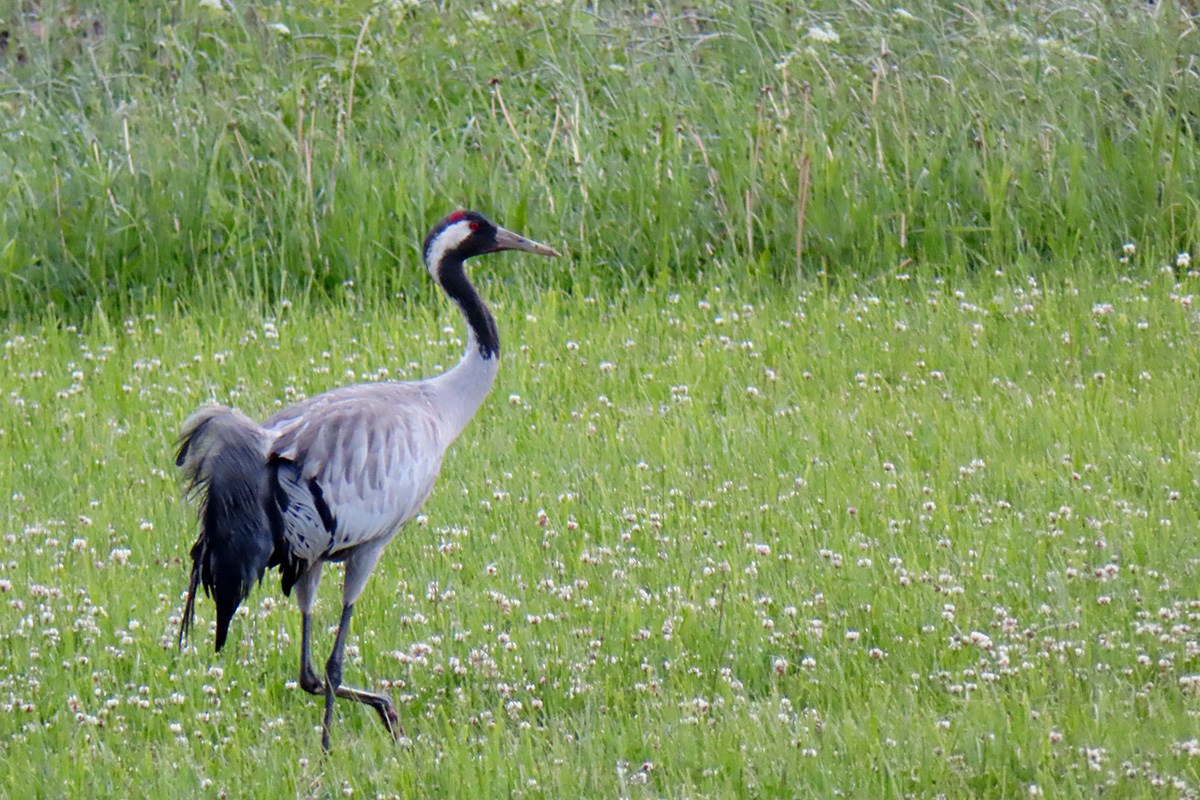
Nous restons 4 jours à Umeå avant le départ et l’on découvre la vie dans le nord l’été et l’imaginons pour l’hiver (Des prises électriques à chaque emplacement de parking, des rampes de lampes à l’avant de beaucoup de voitures).
Une sympathique boulangère de Brioude nous explique (en plus de nous nourrir) que les prises sont destinées à éviter le gel des moteurs, et les rampes de lampes à éviter les animaux qui traversent les routes…
La veille du départ
Le samedi avant la randonnée, nous participons à un Coffee Ride avec des autres participants à la MSR et nous rentrons dans une ambiance qui ressemble au PBP avec le nombre de nationalités différentes! A noter que certains participants connaissent Mozac car ils ont fait des BRM chez nous. Le buffet du samedi soir continue de nous mettre dans l’ambiance. Nous mangeons avec des Polonais et des Allemands…
Le jour du départ
Le dimanche, direction le site de départ. Grosse sieste (ou mini nuit) après le repas de midi. Repas du soir avec les autres participants, retrait du brevet puis temps calme avant de se préparer.
Chargement du vélo avec tout le nécessaire pour le froid (au cas ou) et la pluie. En plus deux sandwichs, deux bananes, des barres pour les étapes longues à venir. Sans possibilité de se restaurer entre les contrôles Les différentes batteries de rechange. L’appareil photo… Départ à 23h05 depuis le parking sans les lumières qui ne seront utiles que dans 3 tunnels.
Etape 1 (69 km) vers Granö
Assez facile. Je roule dans différents groupes successifs pour éviter de surchauffer. Globalement des faux plats assez faciles à passer. Premier contrôle et ravito light avec des boules au goût genre noix de coco.
Etape 2 (53 km) vers Lycksele
Je la fais seul (volontairement pour tester et aussi pouvoir faire des photos) ce qui sera le cas pour le reste du parcours. Etape toujours assez facile avec des montées douces. Premier repas à Lycksele.
Etape 3 (118 km, 240 km cumulés) vers Vilhelmina
Des grandes routes dans les forêts avec des faux plats montants longs. Un contrôle secret (Risträsk ?) sur le parcours à 45 km de Wilhelmina. Très sympa et typique dans un « village » de neuf habitants sur une surface de 400 kilomètres carrés! Un sandwich d’renne tué par le bénévole du ravito (Il y avait aussi une option veg).
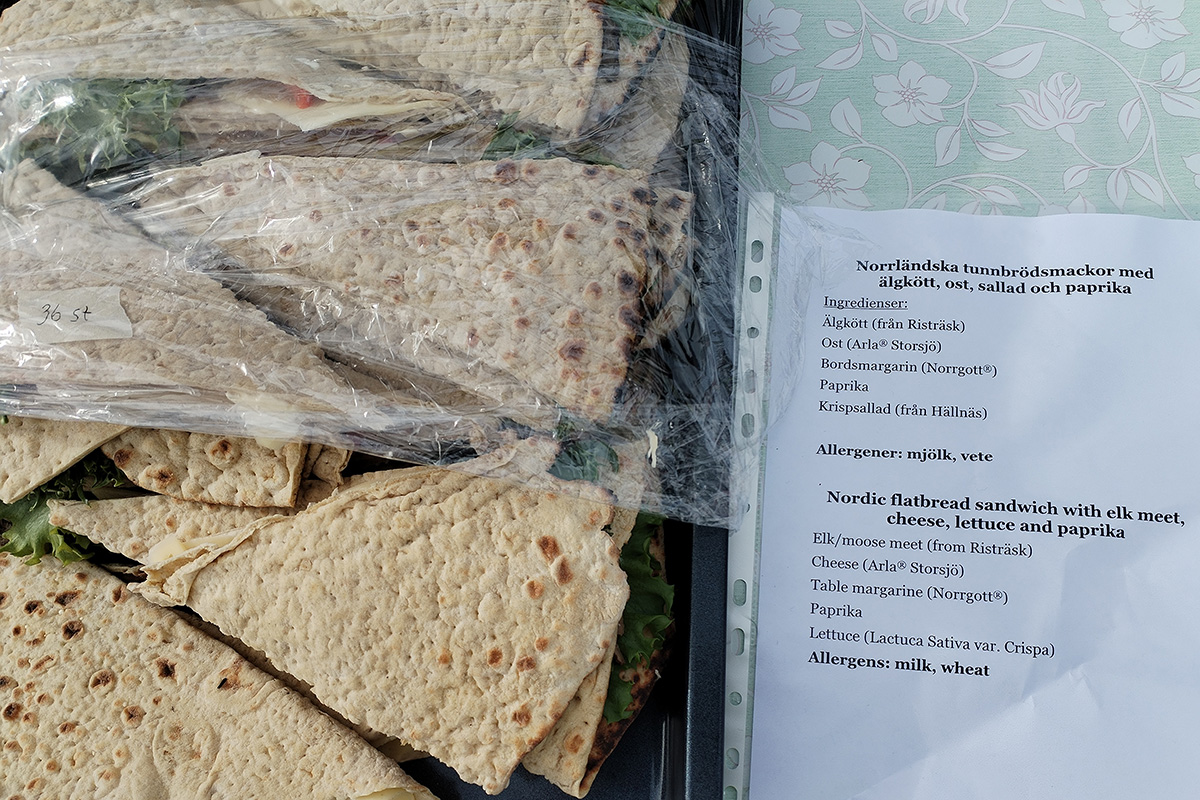
Première rencontre d’un Renne sur la route entre le contrôle secret et Vilhelmina. A Wilhelmina, premier point de contrôle avec Agnès. Petit déjeuner dans l’hôtel (œufs brouillés, bacon, …). Un ours et un loup empaillé dans l’hôtel! Je reprends des sandwich et des bananes pour les 300 km à venir. Vent dans le dos maintenant jusque Mo I Rana.
Etape 4 (129 km , 370 km cumulés) vers Kittelfjäll
Je la trouve encore assez facile (pourtant montagneuse).
Etape 5 (99km, 468 km cumulés) vers Hattfjelldal
Etape 6 (95 km, 564 km cumulés) vers Mo I Rana
Ces étapes sont montagneuses avec beaucoup de gros talus. Des paysages fantastiques avec les montagnes, les lacs, les torrents, la lumière du soleil de minuit qui commence à se refléter dans les nuages. Des élans, des bécasses, une chouette ou un hibou blanc sur l’étape. Je retrouve le camping-car à Mo I Rana pour une nuit de 3 heures (réveil avant le retentissement de la sonnerie du réveil).
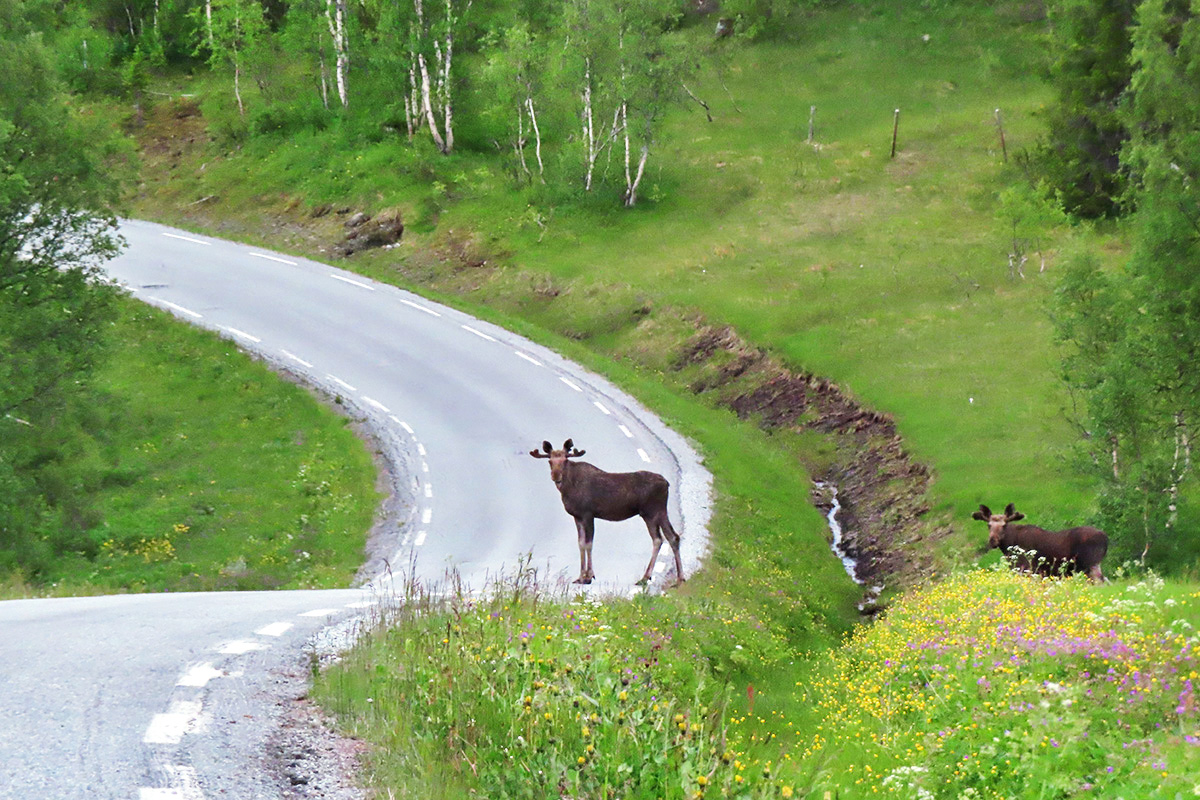
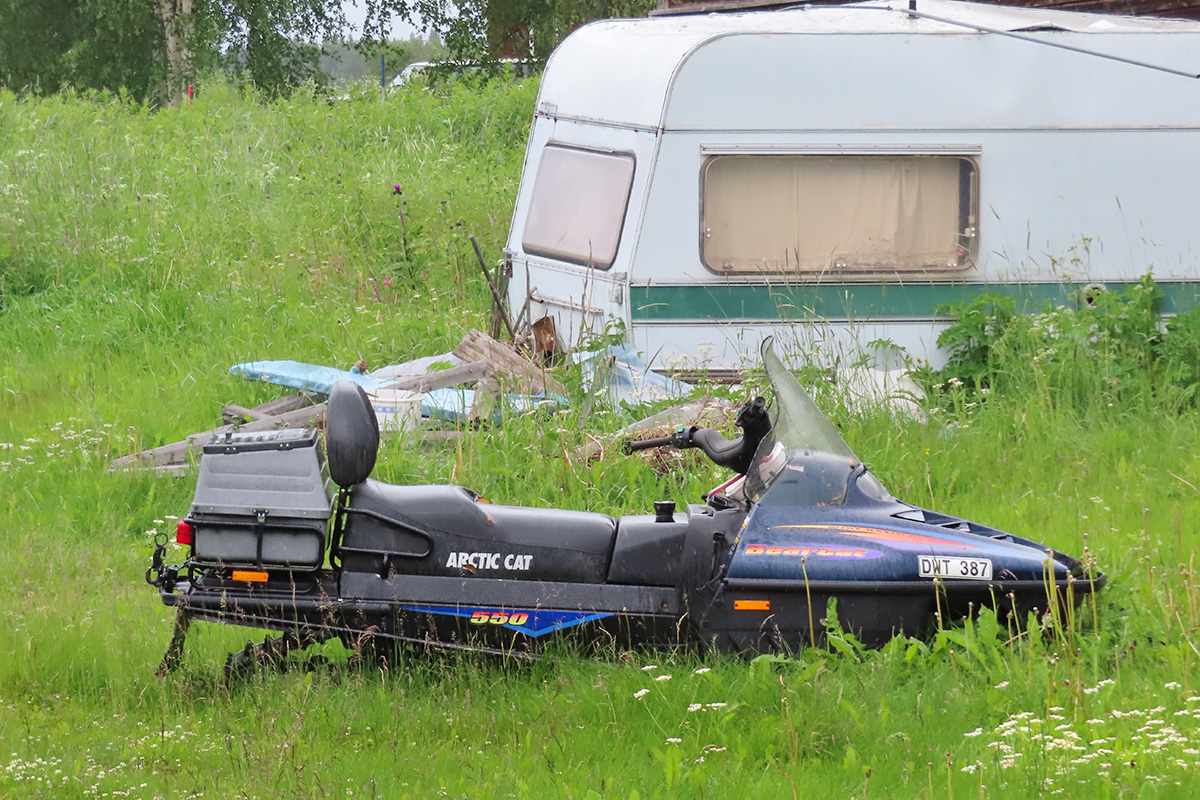
Etape 7 (98 km, 661km cumulés) vers le cercle polaire
Toujours bosselée avec, pour une fois, une circulation relativement importante (pour la Norvège) jusqu’au cercle polaire. Je retrouve Agnès qui voulait voir le cercle polaire et décide de faire tous les prochains contrôles pour profiter des paysages. Un ours polaire empaillé au ravito.
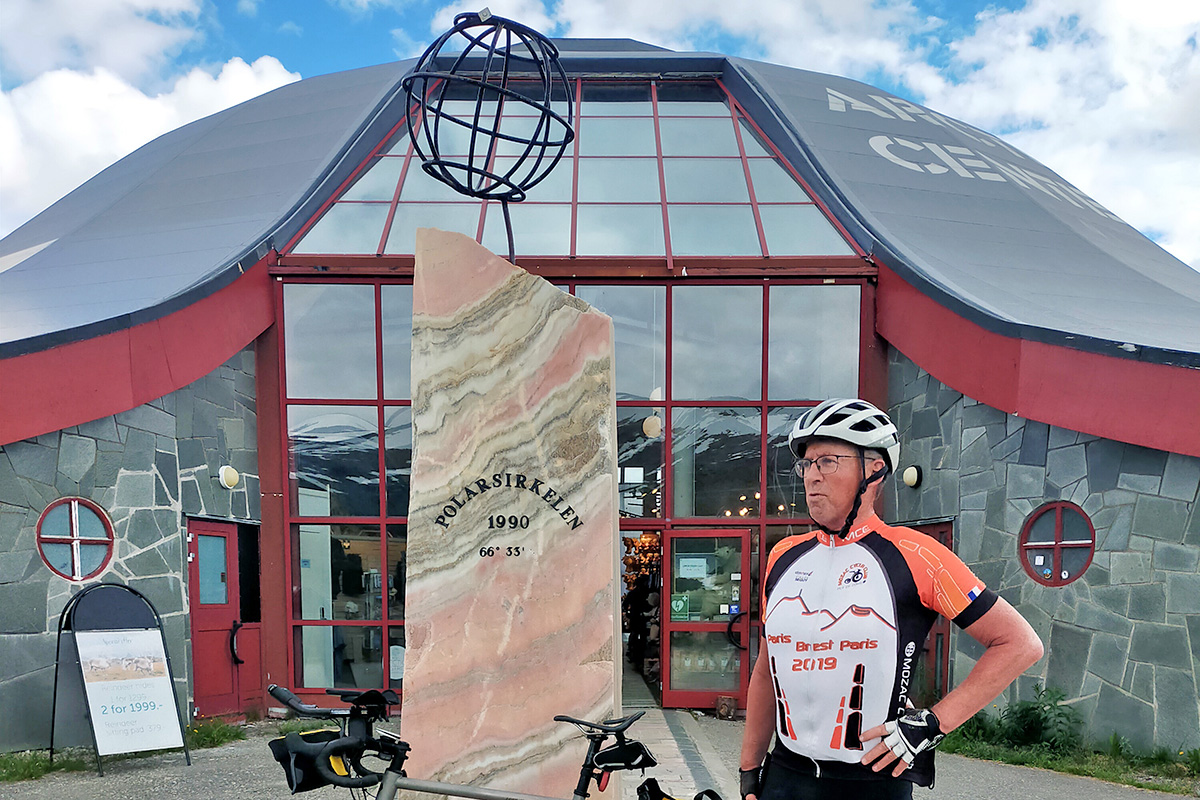
Etape 8 (93 km, 754 km cumulés) vers Vuoggatjålme
Elle est toujours difficile avec de nombreuses bosses. Des paysages fantastiques de Montagne. Un limicole qui alerte. Le contrôle se fait sur un presqu’île au milieu de lacs immenses, dans une « Auberge » tenue par des Français de Besançon (Hiver dur dans ce lieu qui détient la deuxième température enregistrée en Europe -52°C). J’essaie de dormir mais après une heure, je repars sans avoir dormi.
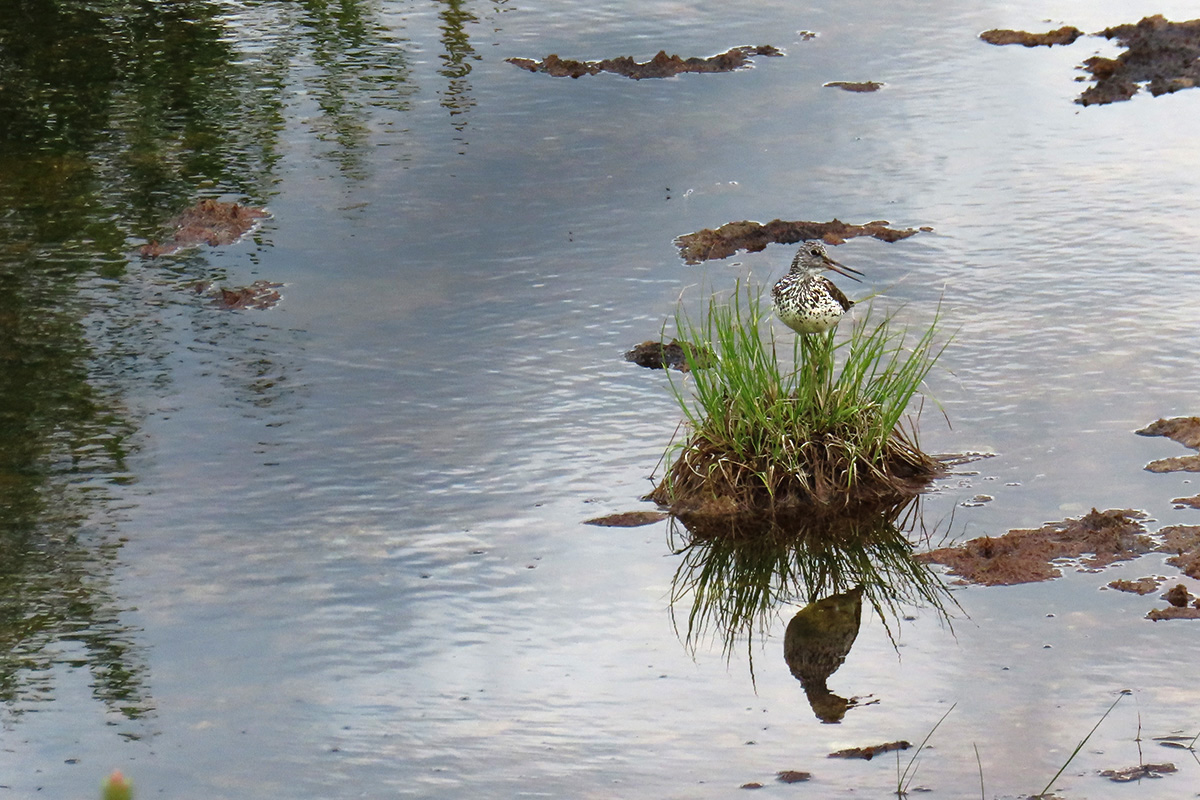
Etape 9 (105 km 859 km cumulés) vers Arjeplog
Elle est plus facile avec des paysages fantastiques surtout avec le soleil de minuit qui perce dans les nuages qui se reflètent dans les lacs, … Bien suivre la trace pour trouver l’hôtel (L’hôtel est sur une presqu’île au milieu d’un lac immense)! Un lynx empaillé. Après un petit repas avec des pâtes très bonnes. J’aperçois un lièvre entre l’hôtel et le camping-car. Direction le camping-car pour un cycle de sommeil de 3 heures (toujours pas besoin de sonnerie pour le réveil).
Etape 10 (91km 949km cumulés) vers Sorsele
Elle est assez facile. Plusieurs troupeaux de rennes sur le parcours. Des moustiques aussi (surtout ne pas crever). Trace toujours facile à trouver avec prochain changement de direction dans une centaine de km! Plusieurs centres d’essai de constructeur automobile sur neige au début du parcours. Il commence à pleuvoir en fin d’étape. Je prends mon temps au contrôle et discute avec un suédois qui parle Français (il a une maison à Caen). Je me demande quand repartir avec la pluie (annoncée pour durer encore 5 heures). Finalement je repars sous la pluie battante en espérant la doubler (des allemands eux vont attendre). Une à deux heures après j’ai gagné.
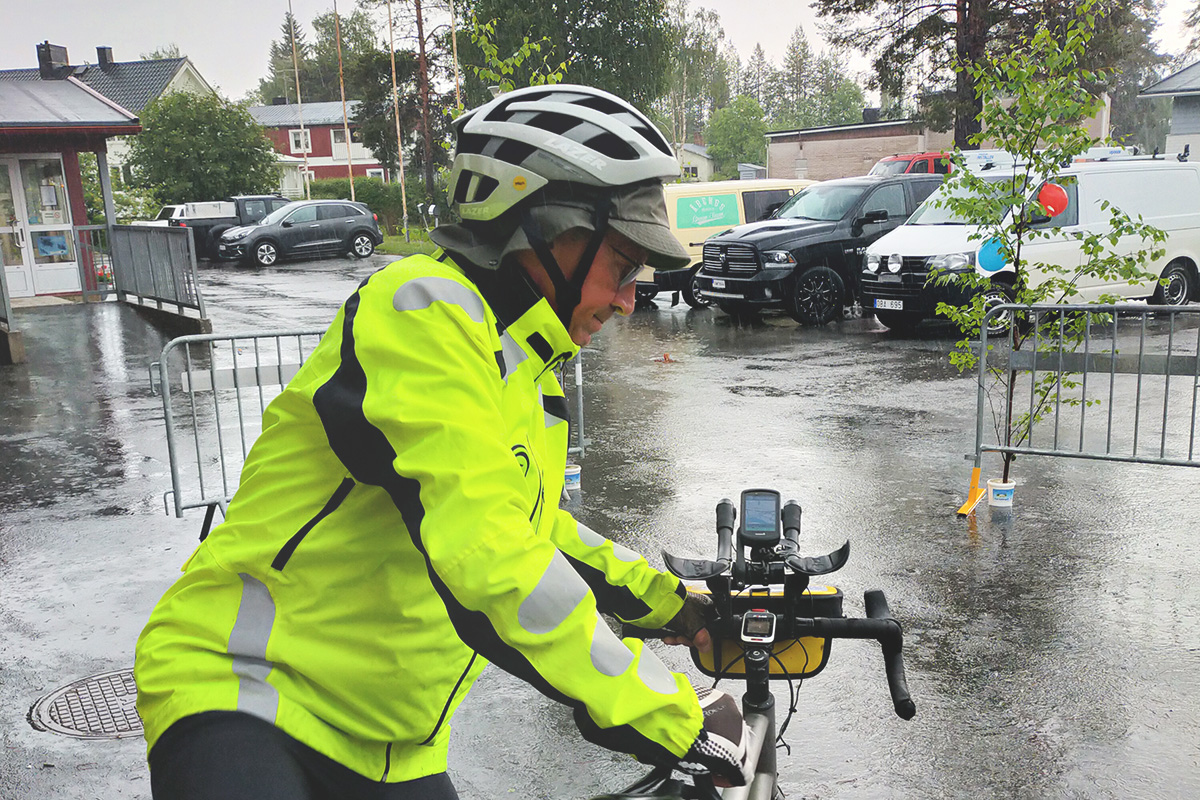
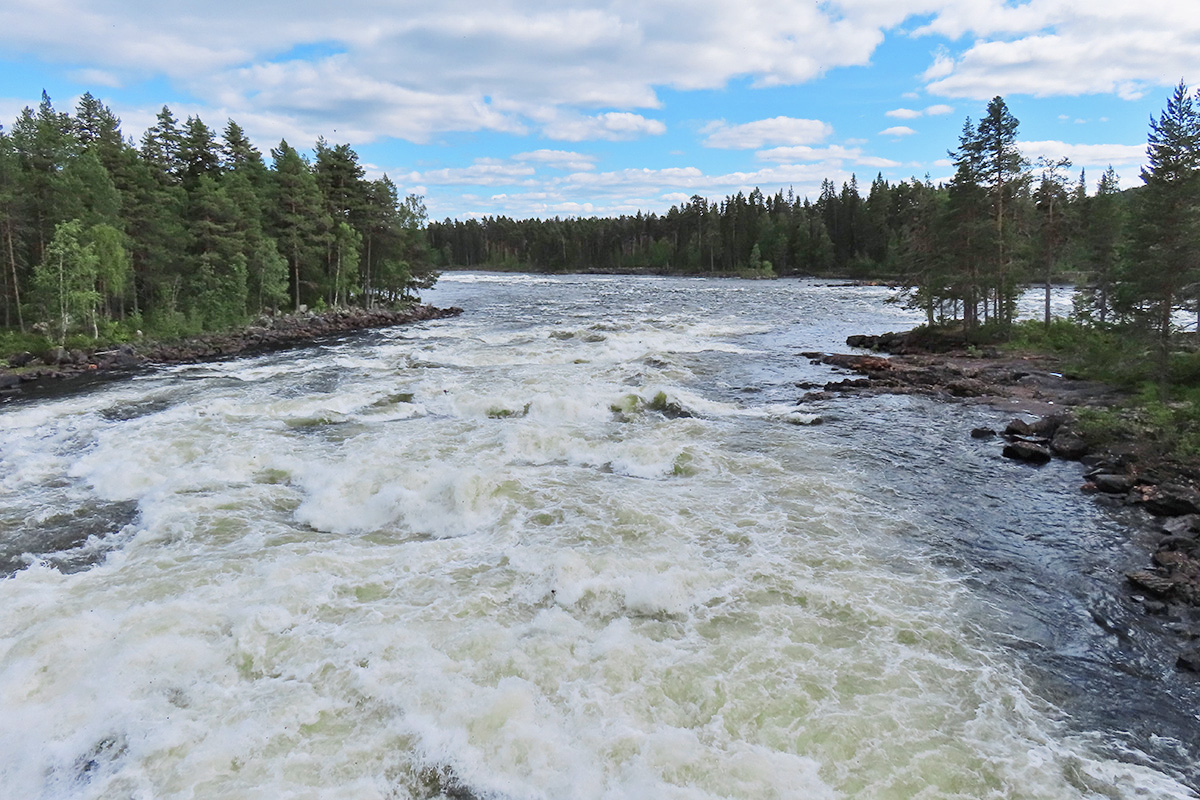
Etape 11 (157km 1107 km cumulés) vers Åmsele
Elle est longue et assez facile. Les cyclos espèrent qu’un contrôle secret permettra de la couper. Je pars avec deux sandwichs, des bananes… On suit très longtemps un torrent large et puissant. Contrôle secret bien caché dans le creux (ne pas manquer les fanions qui l’indique) en dessous de la route au bord d’un torrent énorme! Très sympa avec un barbecue, des saucisses et un gâteau suédois. Contrôle autour d’un barbecue à Åmsele avec un suédois qui a fait de la moto et couru avec Christian Sarron. Nous sommes 3 Français au contrôle.
Etape 12 (107 km 1213 km cumulés) vers Umeå
Dernière étape assez facile avec du vent dans le dos. Arrivée à 0h36 un peu bizarre à l’hôtel! Seulement Agnès et la réceptionniste de l’hôtel pour valider le brevet.
Le lendemain de l’arrivée
Le lendemain, direction la boulangerie pour déguster un MSR (Paris-Brest fait avec du chicouté) prévu dans l’organisation du MSR. C’est l’occasion de retrouver des cyclos (Anglais, New Yorkais, Suédois) avec lesquels nous échangeons.
Super expérience, super randonnée avec un goût de reviens y!
Jean-Paul Briot
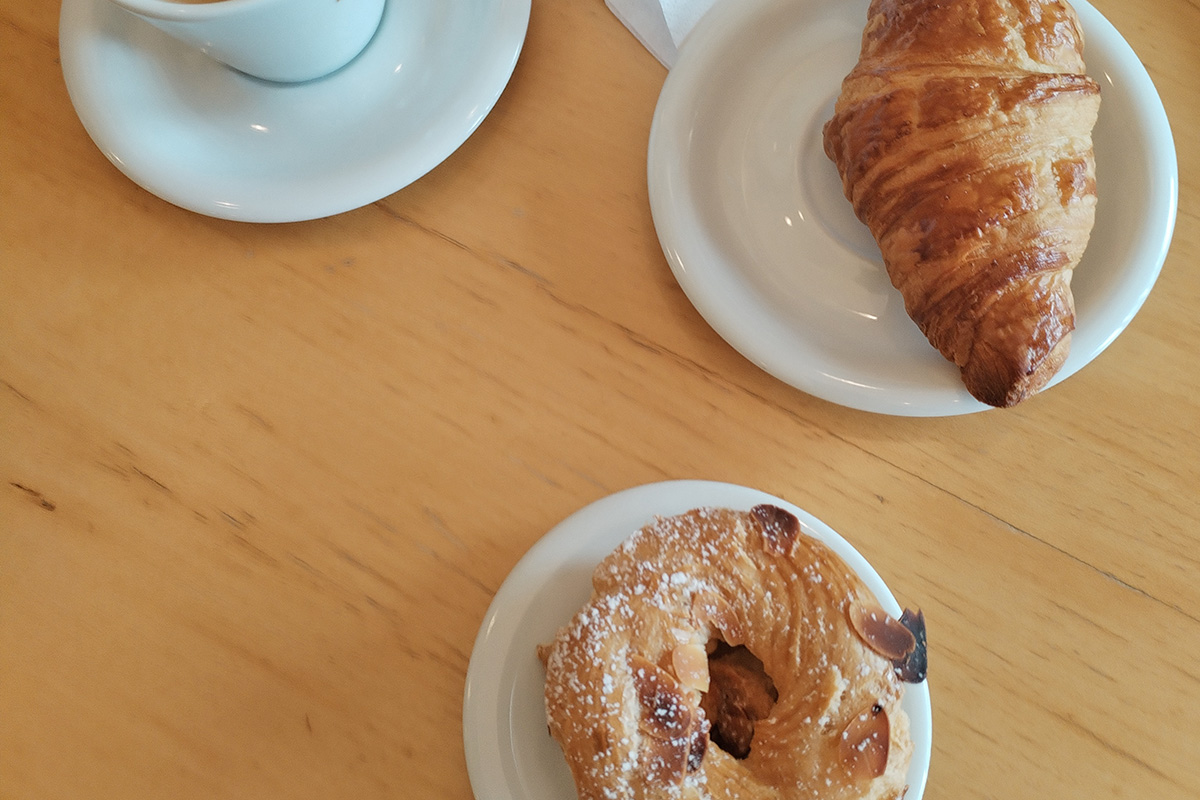
Great trip to Sweden
Great for cycling (in summer). Roads generally in very good condition. Lots of cycle paths (including in villages). Drivers respectful of cyclists. Even the big Swedish lorries keep a distance when overtaking. Wide open spaces with very few cars. The south is relatively agricultural, although there are lakes (100,000 in Sweden) and forests. The further north you go, the more you find yourself in immense forests, then high moors and mountains (the Scandes) towards Norway.
Super BRM. The Midnight Sun Randonnée is similar to Paris-Brest:
- number of nationalities 19
- distance 1 213 km
- total ascent 11 500 m D+
Differentiating features:
- Only 100 participants
- A looped route rather than an out-and-back
- Altitude difference mainly in the second third of the route
- Nobody on the roadside, especially not at night
Overall, a great route through fantastic scenery, particularly in the scenery of the midnight sun. Very few cars. Forests, lakes, torrents (huge ones), mountains, furry and feathered animals. A taste of coming back!
P.S. Also, it’s not difficult to create routes!
Details on our trip and the tour
After passing through England, we cross Belgium, Holland, Germany and Denmark to reach Sweden in Malmö. We’re taking advantage of the trip to go cycling and tandem biking. Cycling is much easier in all these countries than in France, with cycle lanes everywhere (and they’re passable!), stop signs for cars and calm behaviour. It took us a week to get to our start location in the north, alternating between cycling, driving and sightseeing.
Sweden has a huge contrast between the relatively populated agricultural south and the north, with its immense forests of pine trees and birch. Spring and early summer come together, and we see flowers galore along the roads and around the houses: lupines everywhere, lily of the valley, rosebushes in bloom, raspberries formed in the south and in bloom in the north, cranes, lakes, rivers… We stayed in Umeå for four days before departure, where we discovered what life is like in the north in summer and imagined what it would be like in winter (electric sockets in every parking space, lamp rails on the front of many cars). A friendly baker from Brioude explained to us (as well as feeding us) that the plugs were designed to prevent the engines from freezing, and the lamp rails to see wildlife crossing the roads.
The day before the start
On the Saturday before the ride, we took part in a coffee ride with other participants in the MSR and got into an atmosphere that resembled the PBP in terms of the number of different nationalities! Some of the participants know my home town Mozac because they’ve done BRM:s there. The buffet dinner on Saturday evening puts us in a good mood. We eat together with Poles and Germans…
Start day
On Sunday, we headed for the start site. Big nap after lunch. Evening meal with the other participants, collection of the brevet, then some quiet time before getting ready. I loaded the bike with everything I needed for the cold (just in case) and the rain. Plus two sandwiches, two bananas and bars for the long stages ahead. No possibility of eating between controls. The various spare batteries. Also, the camera… Departure at 23:05 from the car park without lights, which will only be useful in three tunnels.
Stage 1 (69 km) to Granö
Quite easy. I’m riding in successive groups to avoid overheating. On the whole, the false flats were fairly easy to get through. First checkpoint and light feed station with coconut-flavoured balls.
Stage 2 (53 km) to Lycksele
I did this stage alone (deliberately to test it out and also to be able to take photos), which was to be the case for the rest of the route. Still a fairly easy stage with gentle climbs. First meal in Lycksele.
Stage 3 (118 km, 240 km combined) to Vilhelmina:
Big roads in the forests with long rising false flats. A secret control (in Risträsk?) on the map 45 km from Vilhelmina. Very nice and typical in a ”village” of nine inhabitants in an area of 400 square kilometers! We ate a moose sandwich (killed by the volunteer) at the feed station (there was also a veg option).
First encounter with a reindeer on the road between the secret control and Vilhelmina. At Vilhelmina, first checkpoint with Agnès. Breakfast at Hotel Wilhelmina (scrambled eggs, bacon, etc.). A stuffed bear and wolf in the hotel! I eat sandwiches and bananas for the next 300 km. Now a tailwind all the way to Mo I Rana.
Stage 4 (129 km, 370 km accumulated) to Kittelfjäll
I still find it fairly easy (despite being mountainous).
Stage 5 (99 km, 468 km accumulated) to Hattfjelldal
Stage 6 (95km, 564km combined) to Mo I Rana
These stages are mountainous with lots of steep climbs. Fantastic scenery, with mountains, lakes, streams and the light of the midnight sun beginning to be reflected in the clouds. Moose, woodcock, an owl, perhaps a Snowy owl, on this stage. I meet up with the camper van at Mo I Rana for a 3-hour nap (I wake up before the alarm goes off).
Stage 7 (98 km, 661km accumulated) to the Arctic Circle
Still hilly with, for once, relatively heavy traffic (for Norway) all the way to the Arctic Circle. I meet up with Agnès who wanted to see the Arctic Circle and decides to ride to the next control to enjoy the scenery. A stuffed polar bear at the feed station.
Stage 8 (93 km, 754 km cumulative) to Vuoggatjålme
Also a tough stage with lots of climbs. Fantastic mountain scenery. An alert wader… The checkpoint is on a peninsula in the middle of huge lakes, in an ”Auberge” run by French people from Besançon (a harsh winter here, which has the second-lowest recorded temperature in Europe -52°C). I try to get some sleep, but after an hour, I set off again without having slept.
Stage 9 (105 km 859 km accumulated) to Arjeplog
This is an easier stage with fantastic scenery, especially with the midnight sun breaking through the clouds reflected in the lakes… I follow the signs to the hotel (the hotel is on a peninsula in the middle of a huge lake)! A stuffed lynx. After a small meal of very good pasta. I spot a hare between the hotel and the camper van. Off to the camper van for a 3-hour nap (still no need for the alarm clock).
Stage 10 (91km 949km accumulated) to Sorsele
This is a fairly easy stage. Several herds of reindeer along the way. Mosquitoes too. The route is easy with the next change of direction in around 100 km! Several car manufacturer test centres on snow at the start of the stage. It starts raining at the end of the stage. I take my time at the checkpoint and have a chat with a Swede who speaks French (he has a house in Caen). I wondered when I could set off again in the rain (which was forecast to last another five hours). Finally I set off again in the pouring rain, hoping to get through the rain clouds (some Germans wait it out). I gained one or two hours.
Stage 11 (157km 1107km accumulated) to Åmsele
It’s long and fairly easy. Riders hope that a secret control will make it feel shorter. I set off with two sandwiches, bananas… We follow a wide, powerful river for a long time. The secret control is well hidden in a hollow (don’t miss the flags indicating it) below the road on the edge of a huge torrent! Great fun with a barbecue, sausages and Swedish cake. Barbecue checkpoint in Åmsele with a Swede who has ridden a motorbike and raced with Christian Sarron. We were three Frenchmen at this checkpoint.
Stage 12 (107 km 1213 km accumulated) to Umeå
Last fairly easy stage with a tailwind. Strange arrival at the hotel at 0:36! Only Agnès and the hotel receptionist are awake to validate the brevet.
The day after arrival
The next day, we headed to the bakery for a Soleil de Minuit (Paris-Brest made with Cloudberries) which was been planned as part of the MSR. It was an opportunity to meet up with other cyclists (English, New Yorkers, Swedes) with whom we chatted.
A great experience, a great ride with a taste of coming back!
Jean-Paul Briot
Florian Kynman
In contrast to the weeks of relatively stable weather ahead of the event, the weather report for the Midsummer week predicted scattered rain showers with interims of sunshine. Exactly where and when there would be rain or sun was however anyones guess.
The many uncertainties made the choice easy to carry the extra weight of fully waterproof rain clothes on this ride. On the mountains stages, but also during the night stages, the importance of keeping warm and dry cannot be understated in this sparsely populated region where shelter is many times hard to find.
A thick layer of rain clouds engulfed the start location during most of the day but in the evening before start the skies cleared up a little and the rain stopped. The chef and saxophonist from previous years no longer worked at Brännland Inn so to the start MSR this year the presenter initiated ”a final count” instead.
Following the Ume river on the E6, the first stage was relatively flat and the peloton kept a good pace. It was also soon apparent that we had a substantial tail wind. A wind that would continue to blow in our favour all the way to Norway. During the first hours the peloton thinned out and split up into smaller groups. After 69 km we arrived in the village Granö where a quick stop was made for a sweet and coffee.
Still standing in line to get my brevet card stamped the first group of riders set off towards the next checkpoint Lycksele, crossing the suspension bridge over Ume River. As I also crossed the bridge, larger chasing groups arrived. Out on the road again I spotted the ”leading group” at a distance and decided to catch up with them. This was not the first group proper however because, way ahead of all cyclists, Matthias Hübner and Simon Wawerka were speeding ahead in their velomobiles. Matthias and Simon extended their lead as the ride progressed, eventually finishing long before the next rider.
With a steady tail wind we made good speed to Hotel Lappland in Lycksele where it was time for the first meal of the ride. I hadn’t filled my water bottles before start so I wandered off into the hotel’s dining area where I found water and also a coffee machine. The dining area was separate from the lobby where we had been eating. When returning I found that I’d missed the departure of the leading group again and so I would ride solo on the next stage to Vilhelmina.
Leaving the Ume River valley the stage between Lycksele and Vilhelmina featured a series of long shallow gradients up to about 600 m a s l before gradually descending again to down to Vilhelmina. There was a secret checkpoint on this stage and I arrived there just as the first group of riders were getting ready to leave. My brevet card was stamped. I ate a soft flatbread sandwich with slices of meat and cheese and drank a cup rhubarb juice. Then I was back on the road again.

By the end of the stage I’d caught up with a few riders from the first group. The rest were about to eat breakfast when I arrived to the fourth checkpoint, Hotel Wilhelmina. The breakfast buffet had much to choose from. My breakfast consisted of pancakes with raspberries and whipped cream together with slices of watermelons and at least two cups of coffee.
Getting ready to leave, a group of three riders joined me: Reijo Tikka, Sven Cederberg and Martin Bergström. It turned out we would keep company for most of the rest of the ride.
The first half of the following stage along Lake Malgomaj was relatively flat and we kept a fair pace the next 61 kilometers to Stalon (a settlement with the only petrol station and food store in the area) where we turned off road 1067 and headed further north on road 1077 to Dikanäs. With the snow capped mountains of the Scandes mountain range in sight the first proper climb of the ride then started.
Approaching lunch time, Kittelfjäll, the fifth checkpoint was not far away. Temperatures were around +20°C. We had a tail wind and cumulus clouds covered most of the sky providing shade. All in all, we couldn’t ask for better cycling conditions on this the first day of the randonnée.

In Kittelfjäll we stopped for lunch at Fjälltorget. The restaurant offered a choice between Pasta Penne Ratatouille, Pasta Bolognese and Pasta Carbonara. Here I noticed that the battery on my Garmin was already half empty and I realised that I’d forgotten to bring my battery pack. Luckily the checkpoint volunteer had a charger so during lunch I charged my device. Trying to keep my Garmin alive later became one of my main concerns during the ride. Turning the device off and on repeatedly to save batteries led to all the sensors disconnecting from time to time with the only solution then being to do a hard reboot.
On the way out from the restaurant we met the next group of riders arriving to Kittelfjäll. Having completed the first of the hilly stages, the next stage between Kittelfjäll and Hattfjelldal was one of the toughest but also one of the most scenic stages. The stage finished with a few long downhill runs and a couple of unexpected climbs which built an appetite for the next meal, fish soup and focaccia, at Hattfjelldal Hotel.
After dinner, an interview with the local newspaper awaited for my part and then our small group set off again on the seventh stage to Camp Yttervik. A stage that started with a two kilometer long and fairly steep climb up to the Norways second largest lake, Røssvatnet. Sven’s bike was equipted with a dynamo hub and offered to charge my device on this stage. We switched Garmins and of the end of the stage the battery on my device was fully charged again. Like the previous stage also this stage consisted of narrow winding roads and a never-ending series of small climbs finishing with a long downhill run down to the E6 and the Ranfjord. We were now down at sea level again.


Being the only riders at Camp Yttervik we had four cabins to choose from for a short nap after first refuelling with a couple of salmon wraps and sodas, a banana and sweets. Leaving Camp Yttervik in the middle of the night, traffic on the E6 was at a minimum. Riding through Mo i Rana we made a brief stop at a Circle K for an early breakfast consisting of coffee and sandwich. The stage profile for this stage basically consists of one big gradual climb up to the Arctic Circle Center.
After 42 km, we spotted the outdoor furniture of the MC Museum café in Storforshei. This place offered ideal conditions for a power nap but the sheltered location also provided ideal conditions for mosquitoes and so we pushed on in search of a more windy spot. In Dunderland we found a bus stop where we tried to take another nap. Sitting in the bus shelter a lone rider speeded past us by out on the E6. ”Hola!”, it was Brook Hendersson.
We soon discovered that the bus shelter wasn’t ideal either and so we pressed on. After another 18 km we arrived at Krokstranda Campsite. By then we were all half asleep on the our bikes and so we made a third attempt to have a nap here. To our delight we discovered a building with washing facilities and toilets. A fifteen minute mosquito free power nap made all the difference and so with renewed energy we continued on to the Arctic Circle Center, arriving at 07:30.
Brook was already there when we arrived and had eaten. He was now taking the opportunity to phone home using the free wifi. The Arctic Circle Center offered a spicy wrap and waffle buffet so after a few waffles and cups of coffee we set off again for Vuoggatjålme. Low-level stratus clouds dominated the sky. It seemed only to be a matter of time before we’d cross paths with a rain cloud on this the second day.
After a long downhill run down from the Saltfjellet plateau and the Arctic Circle Center we turned off the E6 onto a road closed for traffic, except bikes. This was the old national highway. The road balanced on the edge of a ravine leading into the Junkerdal valley. This was one of the steepest and longest climbs of the course but it also offered spectacular views.
After crossing back over the border to Sweden and completing the final climb up to the highest point of the course we descended down to the ninth checkpoint Vuoggatjålme on wet roads, arriving at 13:00. I drank non-alcoholic beer and coffee together with my meal. With the last stage in mind we agreed to take another short nap in one the cabins instead of trying to sleep next to the road.
The sun was shining when we left Vuoggatjålme but rain clouds were soon lurking all around us. Making a stop at the food market in Jäkkvik we assed that there would be no escaping a particularly dark cloud a few kilometers ahead of us so we put on our rain jackets. Out on the road another lone rider, Simon Healy, passed by. Setting off again the predicted rain started and soon intensified. With my leg warmers getting wet and a cold night stage approaching I decided to get off the road and wait out the worst of the rain under a tree. Back on the road again the rain eventually stopped completely and the sun came out again. By the time we reached Hotel Hornavan in Arjeplog our clothes had dried up. To the south a towering cumulonimbus cloud loomed, potentially bringing both heavy rain and thunder.

At Hotel Hornavan we ate our meal and had a cup of coffee. Simon sat in the hotel lobby when we arrived. He left ahead us. The ominously dark cumulonimbus cloud was still blocking our passage south when it was time to leave so I put on my rain gear again, this time the full kit, rain trousers and all. Heading out the door the night porter in the reception informed me that with the weather report in mind, he was going to turn on the sauna for the incoming riders during the night.
The stage between Arjeplog and Sorsele is flat, relatively straight and consists for most parts of a gradual decent down to Sorsele. On this stage it is very common to see both reindeer and moose and for my group it didn’t disappoint.
As predicted we soon came into contact with the cumulonimbus cloud but by chance the cell hadn’t moved much since we left Arjeplog. It was still centered out on Lake Uddjaur and so we passed it catching only a small portion of rain from the edge of the cell. Out on the lake sporadic bursts of thunder could be heard.
Approaching Slagnäs towards the end of the stage the rain ceased, the clouds broke up and the sun came out again. It was now close to midnight, the air cooled down and out on the marshes fog started to rise.

Cycling stage between Sorsele and Åmsele along the Vindeln River at night would be really cold so our plan was to take one final nap at Sorsele River Hotel and then start out fresh in the morning around 03:30. Simon who had arrived before us decided to join us on the next stage. Before my nap I took a shower in the hotels relax area and left my shoes, socks and gloves to dry in the sauna.
Setting off after 03:30 as planned with dry shoes, after a shower and a nap, I felt fairly good. It was still foggy but the sky cleared up as the morning progressed. Sven had left the hotel an hour ahead of us. We kept a good pace along the Vindeln River down to a secret checkpoint where we made a brief stop for breakfast consisting of sandwiches, hotdogs and coffee, by a fire next to the river.


Back on the road again we soon arrived in the village Rusksele where I knew there would be a food store. The shop was closed but fortunately a shop assistant had started early and saw us peering in through the glass entrance. And so we were let in to buy ice cream, sweets and soda. The sun was now shining again in-between the rain clouds, and with a moderate head wind we pressed on to the final checkpoint Åmsele where the famous fried palt with lingonberries and butter awaited.
In Åmsele we met up with Sven again. He’d had taken a long nap in one of the cabins at the campsite and was now ready to go. Instead it was now Simon who felt drowsy and decided to stay behind when we left on the final stage to Umeå. Also on this the third day the weather reports were uncertain and sky unsettled. Ahead of us more rain clouds were gathering.
Leaving Vindeln another dark cloud blocked the road and with the rain about to start at any minute I made a quick stop to put on my complete rain gear again. No sooner had I pulled up my rain trousers when the skies opened. After a short but heavy burst of cold rain the sun came out again.
We passed by Lake Tavelsjö which had been the destination for the pre-event coffee ride. Then the start location for the event Brännland Inn and finally we reached Hotel Plaza to get our last stamp in the brevet card and a meal.
Florian Kynman (eBrevet Card)

Jay Nadeau
Umea to Kittelfjäll, 370 km
I’ve been to the Arctic about a dozen times, most of them for work, though the first time was doing an organized gravel tour on the haul road from Fairbanks to Prudhoe Bay in 2002. Dubbed the “Arctic Ocean Ride of Pain,” it was anything but painful, with awesome support and my first experience with the joys of the sun never setting. You pitch your tent in daylight! You get up to pee in daylight! Later, doing fieldwork in the Canadian high Arctic near 80 degrees north, I learned how the 24-hour sunshine gave me superpowers. Like a cheesy 1970s comic book, I was Dr Solar! Creature of the Midnight Sun!
So, of course, when there was an announcement of a 1200 km brevet with the title “Midnight Sun,” this was imperative. Impossible to resist. Even though I knew full well that at such latitudes, June 21 isn’t really summer yet. Heck, even in Minneapolis it isn’t summer yet, as the torrential rains of my first double taught me in 1992.
So what. 1200 km with no darkness, to lights to charge, no blinkies. Sign me up NOW. I may never do PBP, and still don’t like flying with the bike, but this was not to be missed.
Europe is also much more clement in its climate at a given latitude than North America. Arriving in Umea, Sweden at 64 degrees north, I would have put it in a category with Montreal or Portland (45°) rather than some place like Iqaluit, Canada, which at a comparable latitude is already hundreds of km above treeline. June 13 was mostly sunny with the occasional light rain shower, and the day before the ride the group was treated to a fun 60 km “coffee ride” out to a charming coffee shop in a small town. We’d revisit these roads several days later en route to the finish…
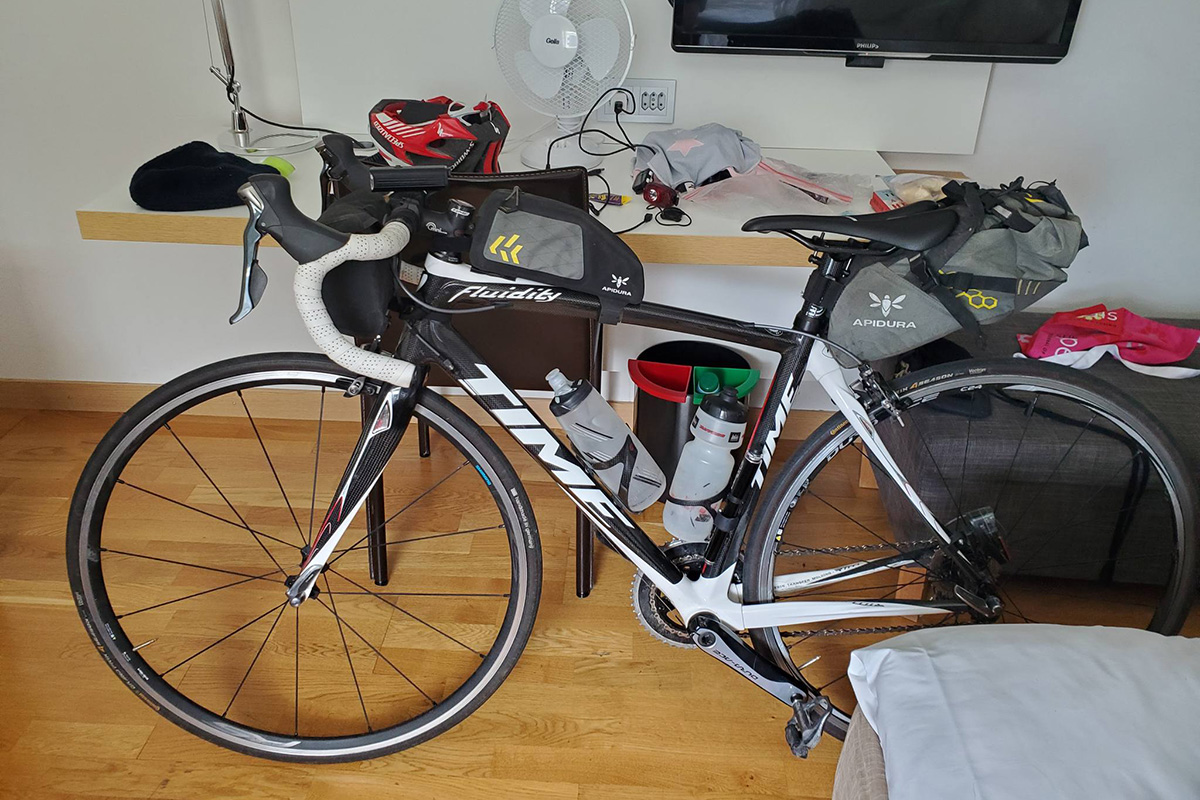
Then began the hardest part of the ride: waiting for it to start. It began at “sunset” at 11:05 pm, so between hotel check-out and the start, there were 11 hours and 5 minutes of waiting. The organizers had set up a couple of neat venues for us to hang out and eat pancakes while waiting, and even some air mattresses, but with pre-race nerves and an afternoon torrential rainstorm, getting rest was impossible. Just 3 km of riding in that rain and I had to clean my bike, wipe off all my bags, and dry out my shoes with towels.
Oh, and bags. No drop bag service on this ride, so you have to carry everything you’re going to need. I had a handlebar bag for food, a top tube bag for electronics, and a rear bag for repair stuff and clothes. The clothes included 2 spare pairs of shorts, because gross chamois is gross, and a full cold-weather kit of heavy Proviz rain jacket and Gore bib tights. Also 4 different types of gloves—rubber, half-finger cycling gloves, fuzzy “hot paws,” and Showers Pass for rain. And with all of that, somehow, Raskolnikov style, I had only one pair of socks.
The last couple of hours of waiting were made more bearable by some banter with locals and semi-locals who had driven to the start, and by a piece of carrot cake split with Alex, a rider from Britain. Just as I was thinking I should have eaten all of the cake and not split it, it was time to line up for the start.
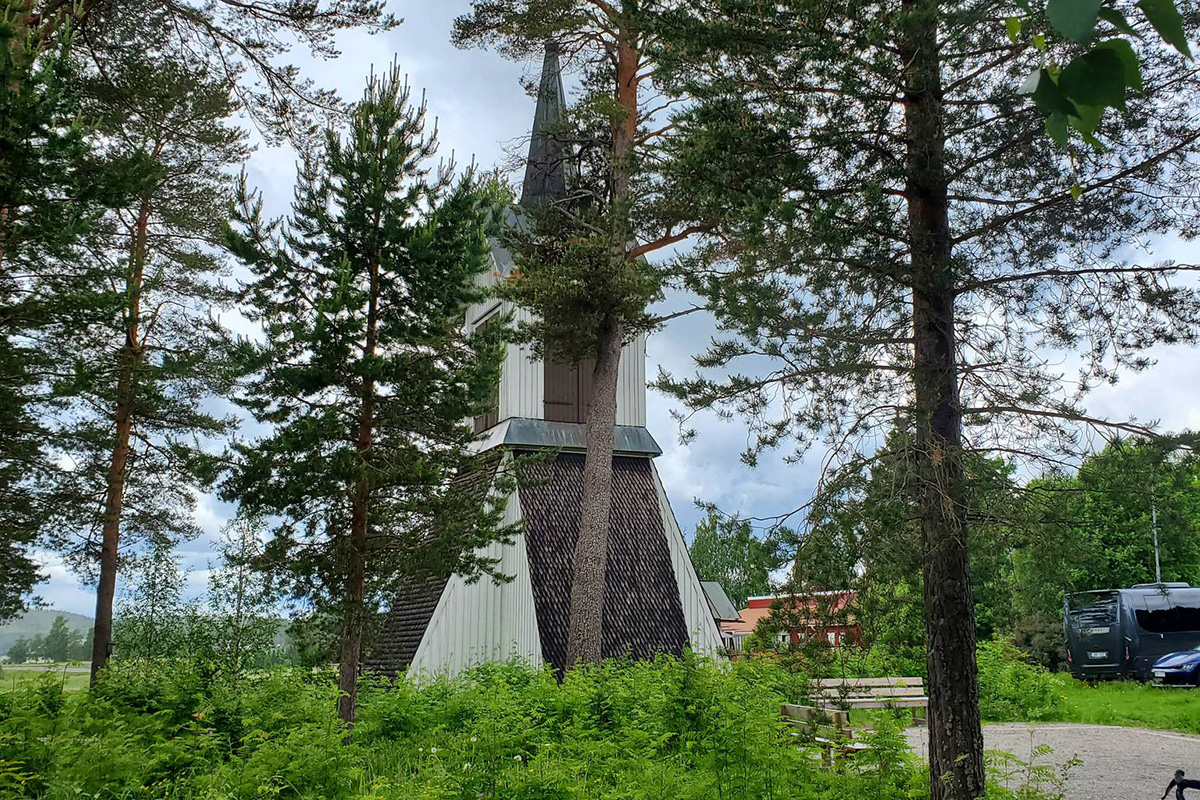
It was definitely still daylight at “sunset,” though overcast. We took the first kilometer or so easy after a warning about a slippery bridge, but then the hammer was down and the average speed would exceed 30 kph for the next 4 hours. There was one control, with barely enough time to grab a chocolate ball before the group was hauling again. The pace felt effortless, and the blue-and-yellow Swedish pennants fluttering from the flagpoles told why: we’d have a good tailwind for nearly half of this 1200 km course.
Brook from Pacific Coast Highway Randonneurs, who’s fast and known for riding through, started grumbling that he needed some time to mix his potions at the next stop. I was relieved, because I don’t use potions and was hoping to get some real food. The complete circadian clusterfark of a 9-hour time change, 11 pm start, and no darkness meant that it was very hard to tell when I was actually hungry.
There was a solid meal at the hotel at Control #2, and everyone sat down to what could have been a Minnesota Scandahoovian pasta salad. I’d get used to choking down mayonnaisey concoctions over the next few days—asking for the vegan option didn’t make a difference except that it’d be some kind of veganaise. Don’t look closely, just eat it.
We were a smaller group when we set out again, just 7, still doing a good pace. There was a male/female couple from Lithuania who it turns out were celebrating their 20th anniversary on the ride (are they divorced yet?) and both were very strong. I think we also might have been with Team Denmark at this point, a group of 4 who had a support van carrying extra clothes and such to make sure they didn’t freeze to death. The Danes held a solid but very manageable pace as the terrain started to roll.
The next control was the “secret” one, and it was here that I realized that the volunteers weren’t riders—they were locals from tiny, tiny towns (population 9!) who kindly opened their homes and sat at tables in the rain for hours to support Florian’s event and his riders. I thanked them effusively, these lovely people who gave us coffee, lemonade, cookies, and sandwiches and let the girls pee in their bathroom (the boys got pointed to a corner of the yard). The flatbread sandwiches were wonderful, and I stuck one in my pocket for later.
Vilhelmina came quickly, and that was 240 km done in 8 hours, a slightly worrisome pace given that we still had almost 1000 km to go. The hotel there offered us a breakfast buffet, making us realize that it was only 7 o’clock in the morning. Sunday? Monday? Tuesday? Who knew anymore. Normal hotel guests calmly went about their breakfasting as we sprawled out, damp and gross and gluttonous, getting ready to tackle the next hilly section.
The section to Kittelfjäll was lovely, with at last a couple of reasonable length climbs. Team Denmark set a good pace, but at some point Brook pulled away. “You’re dropping everyone,” I advised him. “Well, I don’t mean to drop everyone,” he replied. “I just…” …am dropping everyone.
Including me on the downhill. I went easy, thinking the Danes would catch up, but they never did. I noodled along for a bit, enjoying the charming tiny towns and small roads through nowhere. Someone was up ahead at the last turn…
Brook, in a bonk. I wasn’t much better. We piddled along together—he thanked me for “pulling” but with the tailwind it didn’t matter. He kept claiming to see the Danes just behind, but I think this was a hallucination. The last few miles were tough, with some road construction delays and a bit of gravel, the control hotel located on a patch of torn-up pavement. Kittelfjäll is a ski area, and the town was ringed with ski hills and dotted with chalets.
But oh, the Kittelfjäll control was glorious! Made-to-order pasta with ratatouille or meat sauce, unlimited sourdough bread and two types of salad out on the bar. This would be the high point of the food experience, and it was now time to stick to my schedule and have a little nap. It was now 370 km and 14 hours into the ride. I have never ridden a 600 km straight through, so I had promised myself a break here, and the sleeping arrangements were as glorious as the meal: a ski chalet with bunkbed rooms and a big shower area. Brook pressed on, thinking he wouldn’t see me again. I bid him good “night,” showered, put on PJs, and stretched out on a bed with no thought of alarm clocks, hoping the midnight sun would work its magic.
Kittelfjäll to Arjeplog, 489 km
The majority of the next 489 km would be spent alone. There were many ups and downs both literal and figurative.
Riding solo on a hilly course with a tailwind is fun, and I often ride alone in the no-man’s-land between the hammerheads and the ditch-sleeping randos. The downsides are low morale and starting to count kilometers.
No risk of either of those leaving Kittelfjäll, where 90 minutes of sleep had restored me utterly. What time of day was it? Did it matter? It did not. I had a coffee and some sourdough bread back at the restaurant, and then off towards the north again, where the Garmin promised 19 “named” climbs for the next stage.
The weather started out warm and muggy and I soon took off all outer layers, but then the heavens opened. It was a balmy summer shower but the raincoat was essential for the violent drops and walls of wet bugs colliding with me on the descents (some are still in my jacket zipper). Fortunately this was brief, and I paused again to remove the raingear just before the armed guards, razor wire, and long line of traffic at the Norwegian border.
Just kidding. There was a tiny sign that said “Norge,” which I had to search how to pronounce correctly (“Nor-i-geh”). The clouds seemed to have been stopped by customs, though, because just over the border the road was dry and the sky was blue. The hills rolled on and on, scenically. There were lakes. There were trees. I didn’t take any pictures. The pennants indicating the tailwind were now red, white, and blue instead of blue and yellow.
The route pitched downhill for quite a while into the little town of Hatfjelldal, population 1278. The “Hat” in the name is as it sounds, referring to a small mountain shaped like a hat that is one of the few geological features in the area and is apparently a popular day hike. I’m attaching a tourist bureau pic because I never saw the eponymous mountain. Maybe my eyes were too glued to the Garmin, which insisted that another climb remained even as you descended into town.
And indeed, the control was through town and up a twisty little hill to the Hatfjelldal Hotel. I immediately felt right at home, because who came to greet me but Shab Memar, whose husband Hamid Akbarian was riding (of course he was… he does all the 1200ks!). She took this great photo of me and led me inside to a sumptuous feast. There was Brook, surprised to see me—“Guess you didn’t have a long sleep,” he said. “What’s the plan?” “Eat and run,” I promised, thrilled to have almost caught up. “Enjoy the food. The soup is amazing.”
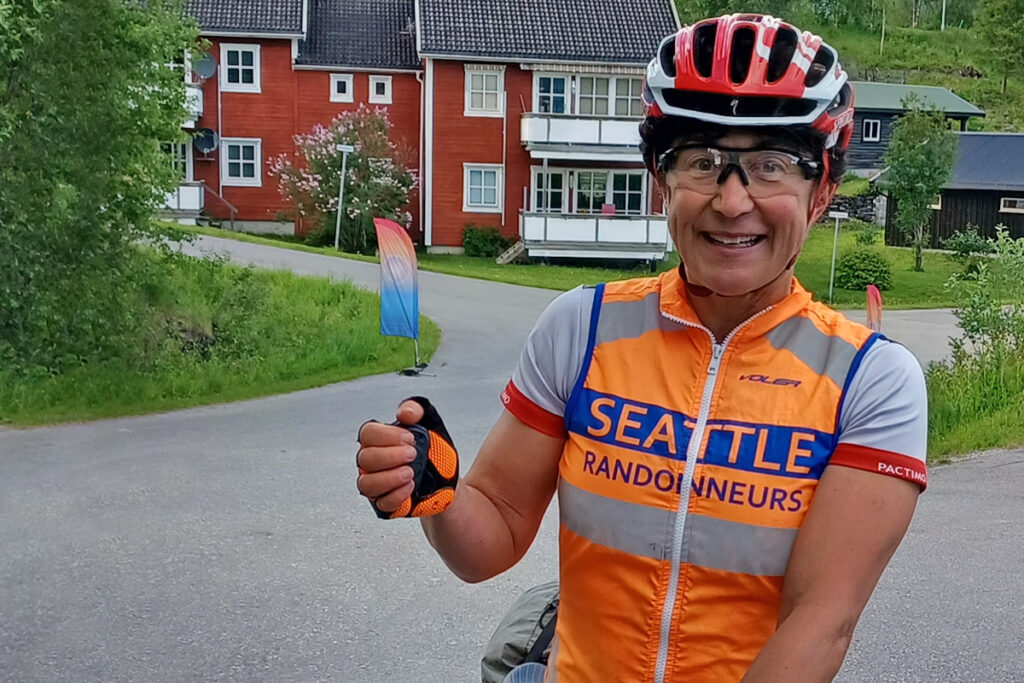
Brook rolled not long after, but he was right—the food was terrific. A rich fish soup, boiled pasta (serve yourself), and a salad with lots of chopped veggies. I should have stayed for seconds, but the next stage was calling: almost 100 km of rolling hills, beginning with a substantial climb and passing through at least two parks. The first was the Vefsna Regional Park, named for the river Vefsna (Vaapstenjeanoe in Sami). Around every corner of the rolling terrain was a beautiful body of water backdropped by green hills and forest. I wondered why no one else was around enjoying the beauty of their country on this lovely summer day…
…Oh, right. It was midnight. 25 hours into the ride, over 550 km covered, and just some descending to the main road before the stop where I had reserved a cabin.
The descents were sweeping and the turns tight, and the roads were wet keeping me alert on that last stretch to the main drag of highway E6. E6 is busy enough that the Garmin kept trying to randomly make me leave it, but after visiting a farmhouse up a gravel road I quickly figured this out and knew to stay on the main road for the duration—except, of course, to turn off to the overnight, which was well marked by MSR flags.
Reserving a private cabin here turned out to be unnecessary, since the organizers had set aside plenty of shared cabins for rest, and no one seemed to be sleeping. I wanted to make the best of his halfway point, though, so I dutifully checked in, took a hot shower, and set an alarm for 7 a.m., over 5 hours away.
Of course, two hours later I was up and refreshed, sun shining through the window. Also starving. I looked longingly at the kitchenette, wishing I had some oatmeal or something else hot to cook. The food options at this stop had been cold and meager, and only while setting out was I able to find some abandoned “overripe” bananas and shove them madly into my pockets like a thieving raccoon before heading back out to E6.
The charmingly named Mo I Rana was an industrial port with lots of traffic even at 5 am, and lots of trucks. Fortunately trucks meant Circle K open at all hours, so I was able to provision for the next stretch up to the Arctic Circle.
It was a long, gradual climb to the Arctic Circle, and gradually the forest gave way to scenery that looked Arctic—bare brown mountains with patches of snow/ice wedges, but having been to Nunavut I am jaded and thought it still looked pretty temperate, with low bushes and liquid water. Off on a hilltop was a post, and I thought that might be the marker for the Circle, but at some point the road turned away from the post and headed up a different ridge. In retrospect that post was probably the Swedish border, right near the top of 1211 meter “Nasafjellet” or “Nasa mountain” (nothing to do with the space agency). There are abandoned silver mines in this area, and several routes on AllTrails. I often fantasize about stopping to peak-bag in the middle of a brevet, but it wasn’t happening now, that’s for sure. The increasing headwind made even the 3% grade annoying, and the tons of tourist traffic made this part of the ride anything but remote.
The Arctic Circle is marked by a large, UFO-shaped structure proudly bearing the inscription “66 º 33’ N”. My first thought upon rolling in was that it would be pretty awesome to do a 66 hour 33 minute finish to honor the midnight sun and its energy-giving powers. Doing some quick rando-math, I decided this was probably possible if I continued to feel as great as I had been so far.
The problem was a growing food debt that wasn’t helped by the meal at the Arctic Circle. There was a cold wrap with mayonnaise and reindeer meat that smelled, even through the wrapper, like old Fancy Feast cans left in the recycle bin in summer. There was also a waffle with jam, which was lovely, and I bought one more and supplemented it with a pack of peanut butter from my bag. I should have bought five or six more, but I hadn’t predicted the difficulty of the next stage.
Leaving the Arctic Circle we went north for just another 30 km or so before heading east and south, back into Sweden. This was not for lack of landmass to the north. The remarkable thing about E6 were the street signs indicating towns hundreds of kilometers away—we were only about halfway up the country of Norway. 400-odd km to the north would be Narvik, and 1000 or so km would bring you to the delightfully named Hammerfest, the world’s northernmost city of more than 10,000 inhabitants.
Thankful not to be hammering to Hammerfest, I endured the descent on E6 (RV drivers suck regardless of continent) and blessedly turned off onto a closed road that bypassed a tunnel on the main highway. It went up a steep hill, revealing breathtaking sub-Arctic panoramas: towering cliffs! Cascading waterfalls! Deep ravines with rushing water! There was a young man walking up the hill who called out something as I passed—probably that walking was easier than riding, which it almost certainly was.
I had enjoyed the steep hill too much, and burned every remaining molecule of glucose in my bloodstream, so the rest of this leg would be a slog. There was a long climb up to the Swedish border, which was more visible than the one into Norway since it was ringed with a halo of EU stars (Norway is not EU, which is why I’d carried my passport on the ride in case there were customs). Dragging myself up the hill, I wondered why I didn’t seem to be moving at all, squirreling around on the pavement…
The rear tire was flat. Walking past the guardrail to a safe spot, I sat for a few minutes and scrounged for trail mix before tackling the repair. It was an obvious large thorn so easy to remove and fix, and I was just finishing pumping when someone caught up and asked if I was OK.
Couldn’t show weakness on a hill, so I sprang into action, realizing how easy it was to get into your own head when all alone. Having someone to chase made life fun again. The Swedish border was at a false summit, with about 400 feet of up remaining before the descent. Then it was a gentle, very scenic downhill to Camp Vuoggatjålme on Lake Vuoggatjålmjaure. Vuoggatjålme holds the dubious record of the coldest temperature ever recorded at a Swedish weather station, -52.6 °C on February 2, 1966. Brr!
In summer it’s a touristy lakeside resort, with camping, hiking, and helicopter tours. The campsite was upscale, with a fancy restaurant inside a building with huge windows giving lakeside views. The restaurant’s menu was drool-worthy, but sadly, the restaurant itself was closed and all that was available was the official pasta salad.
It was a good pasta salad in a generous portion, but I was too wrecked for more than a few bites, taking the rest over to one of the cabins so I could rest and eat at leisure. I alternated napping and eating noodles for a while, wrapped in a duvet and shivering, until finally the blood sugar was restored. I took a hot shower, changed into clean kit, and it was time to head out once more.
Team Denmark’s support car was outside the restaurant, and they assured me that there was a store just a few km up the road. This was blessed news, but I shouldn’t have stopped to chat, because by the time I turned onto the main road it was just past 5 o’clock in the afternoon. Less than a kilometer later was the store, shuttered and darkened for the evening.
Like a seagull with the fries wrenched from its beak, I gave a squawk of despair that attracted the attention of a Dutch couple in an RV. They asked if I spoke Dutch, then German, and I knew enough German to say I was out of food. Much like feeding the gulls at the pier, they tossed together a baggie of gingerbread and Loacker wafers that would sustain me over the next 100 km into Arjeplog. It had been decades since I’d had a Loacker wafer and man, are those things delicious.
The route into Arjeplog was easy, a little headwindy but not too terrible. At the halfway point I stopped to pee and was caught by a small group who urged me to hop on, so I did. It turns out these were Germans who had done PBP together. They planned for a long sleep in Arjeplog at the hotel there, and were pushing the pace in eagerness. I found their riding style odd—each person would pull for 25-30 km at a time, rather than trading off every few minutes. It made me feel like a bit of a parasite just hanging off the back, but it was nice to have some chat after so many solo miles. It was also my first introduction to shameless pee breaks, just stop ‘n’ whiz—who cares? It’s a You’re-a-Peein’ country!
A few drops fell, then a few more. The Germans yelled “RAINCOATS” and we stopped, but it was too late or it was futile. The torrential downpour soaked in and through all raingear, and the group shattered as we all tried to navigate deep puddles and near-zero visibility.
“Twenty minutes too late!” one exclaimed and it was exactly that to the hotel in Arjeplog, where we rolled in one by one, as wet as it is possible to be.
Arjeplog to Umea, 354 km
The Hornavan Hotell in Arjeplog was upscale and clean, and I expected the people at the front desk to recoil in disgust from our muddy, wet, dripping appearance. Instead they greeted us like lost explorers, offered us candies from a jar on the desk and volunteered that there was a free washer/dryer up on the second floor.
Laundry! A dryer had saved my ride on many occasions, including once in Ocotillo, California, right near the Mexican border, where it was not ever supposed to rain. Was there time to wash and dry? Would it be pointless anyway, since we’d just get wet again?
Brook was at a table, eating—what else?—a pasta salad, and surfing Epic Ride Weather. He showed me a forecast that promised the rain going away by 11:30 pm, or just over two hours from now.
Perfect! We made a plan to leave then, though Brook needed to ride alone because a broken spoke had put his rear wheel out of true. He sprawled out in a chair for a nap and I sprinted up the stairs with all my clothes, expecting a line for the laundromat. But no one else seemed to have that idea yet, and the washer/dryer were empty, with free soap! Everything went into the washer. Clean kit! Dry clothes!
Wearing nothing but the brief PJs I’d packed for sleeping, I returned to the lobby for my pasta salad and several shots from the free automatic espresso machine. Again I worried briefly about my disheveled half-nudity, but quickly felt at ease when the Germans were wandering about in towels (anything underneath? Don’t ask). Yay for Scandinavia!
The spa was open till 10, so I was able to get in a long, hot shower and to dry my shoes and insoles with the hair dryers. I felt no need for sleep at this point. The concept seemed to have vanished somewhere on the banks of Lake Vuoggatjålmjaure. By now my lycra was dry, and I was outfitted in clean, warm kit.
But it was almost time to go, and the wool wasn’t drying. I remembered the same thing from Greenland—dryers in cold places aren’t vented to the outside, so the humidity never gets removed and nothing really gets dry. I gave up on my Willamette Randonneurs long-sleeve jersey, stuffing it back into my bag still sopping. Lycra kit with a raincoat on top would have to do.
Brook had already taken off during my last visit to the dryer. The Germans were heading off to bed, planning to sleep a full night and eat at the hotel breakfast buffet. The lobby was quiet now, so it was time to take off before motivation waned (don’t think about the buffet).
It was now just over 48 hours into the ride, and my third and final stretch under the midnight sun. It was twilight, the sun below the horizon but barely, a gentle indirect glow lighting the bodies of water all around Arjeplog. The next stage was quietly contemplative and delightful, with reindeer everywhere hanging out in the road or in greenery just next to it, munching and interacting among themselves. I slowed to try to photograph a mama reindeer and her baby, but they ran off quickly, hooves splaying out. I wondered if the Swedes had Santa Claus stories since the North Pole wasn’t too remote or exotic (in Canada, Santa gets his own postal code because of course the North Pole is part of Canada—you can write to him at H0H 0H0).
A low, slinking shape indicated a carnivore up ahead—could it be a lynx? Getting closer, I saw it was a slightly chonky black and white cat, heading back towards a house. Missed the pic of kitty, too. There were sounds of quacking, and I was finally able to capture a picture of wildlife in the form of some ducks peacefully paddling through a misty pond. 2 am came, and the sun rose large and red through the trees. Weather continued fine.
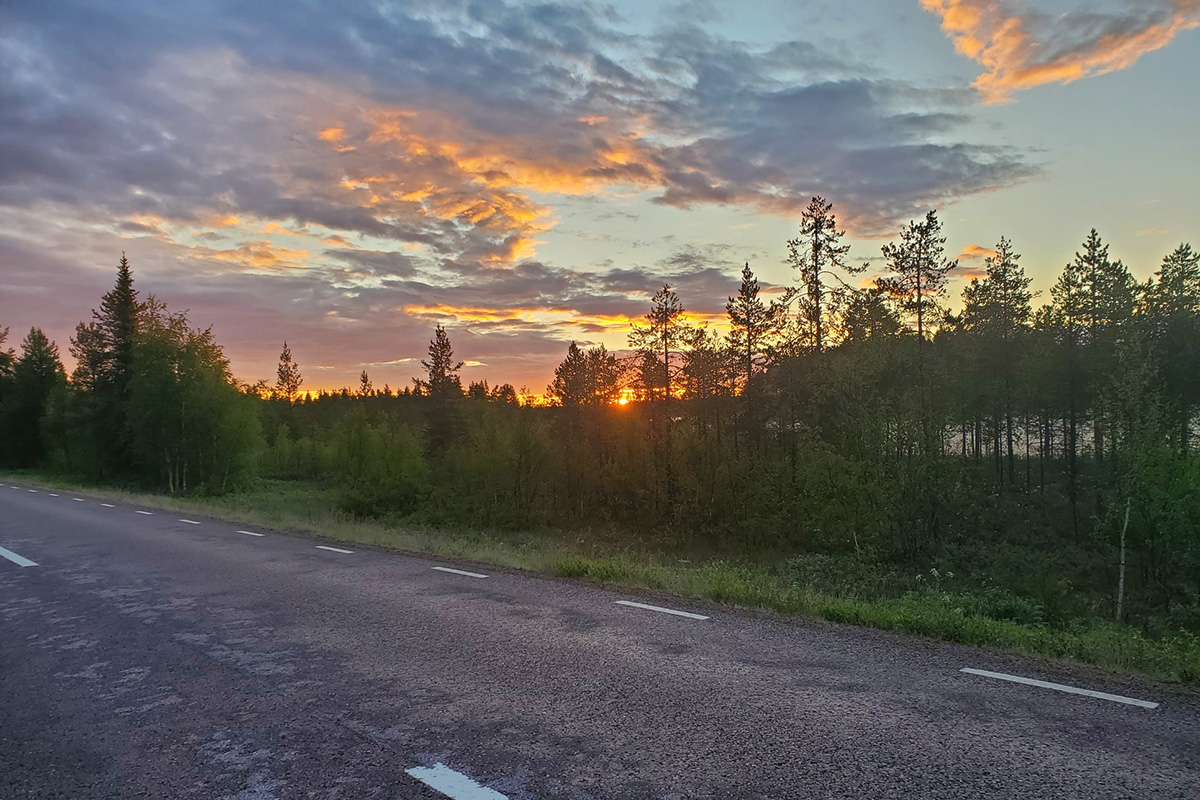
The route turned west at the tiny town of Slagnas, and onto a main road with a 100 kph limit. The first part of that road was torn up and gravelly. Fortunately, in the wee hours there was no traffic of any kind so none of this posed a problem. This part was unmemorable until the last 5 km descent into Sorsele, where I entered a fog so thick I couldn’t see past my front wheel. Headlights were no use, bouncing back from the drops. I turned on my rear blinky just in case any cars should happen by, and slowly picked my way down the hill, only able to see the signs for the hotel as I was upon them. There was more than one hotel in the immediate area, making the town look like a bustling metropolis—though all was shut down at 3:30 in the morning except for the little table of volunteers at the River Hotel.
With a sense of déjà vu I found Brook sitting at a table studying Epic Ride Weather. No one seemed eager to depart into the fog and impending rain, so it was time to attend to some other areas of business. The volunteers were wonderful and immediately pointed me to the spa and sauna area, where I quickly warmed up and hung the still-wet clothes in a hot area to dry. There were meals in a fridge that we could microwave ourselves, and breakfast items in a buffet that we could pay for if desired, including bananas at only 10kr each. The local store wouldn’t open until 8, though allegedly there was a bakery open at 6.
Epic Ride Weather provided no helpful plans for the last 250 km. No matter what we did we were going to get wet. The Finns rolled in and declared they needed sleep, and I thought they might want to team up with me in the morning. No one was leaving at 4 am, anyway, so after some pasta and a stint in the sauna I found an air mattress and passed out.
I awoke at 6 to find the hotel busy with riders. My Garmin somehow hadn’t charged, but I had a spare and didn’t stress too much about it, setting about re-packing for the morning. The Finns were still out cold. Just as I planned to make a dash for the bakery, a big group gathered and made preparations to roll. It was Team Denmark with their follow car and a couple of other riders—a Finn, a couple of Brits, a total of 7 or 8 people. I didn’t know if they had just arrived or if they’d rested a bit, but they were ready to go and this looked like the best opportunity of all to get some good company and share the work into the wind and rain of the last 8 or 9 hours of the ride.
So instead of a cinnamon roll and coffee, I got a couple of slices of crispbread (warning: don’t try to swallow too fast) and some bananas from the buffet table for my pockets, and we were rolling. I was wearing all the raingear in anticipation of a deluge, but we encountered nothing but a few sprinkles as we pacelined out of town. The speed was consistently over 30 kph, everyone taking turns, everyone seeming strong and alert. It was over 150 km to the next control, though we were promised a “secret” control at some point, probably near the halfway point.
Now there were signs for Umea—just 230 km to go. We felt a few sprinkles, but not enough to matter. There was some shameless Eurostyle peeing, where I sadly couldn’t take part because of my bib tights, and I swore those tights were coming off at the secret control.
It didn’t help when one of the British riders kept mentioning how ROASTING hot I must be in my rain gear, how POSITIVELY MELTING in the UNBREATHEABLE fabric.
OK already. I was a bit warm, admittedly. When we got to the secret control I tore off the outerwear like a werewolf ready to transform, stripping down to shorts and short sleeves, the long-sleeved jersey still too wet to wear despite its night in the sauna.
There was a lot of confusion over check-in at the secret control, with no one’s phone working, and in the melée we almost missed the food. You had to ask a few times, and follow the volunteers down a little dirt path to a spot by the water, where there was a cozy campfire and a delicious spread of many types of fruits, sandwiches, coffee, cinnamon rolls, and the thing everyone seemed to talk about—the “hotdogs”—which I tried not to look to closely at. A sack of cinnamon rolls went into my front bag for the 75 km to come.
The next stage was terrific—easy, fast miles with almost no traffic, sometimes in a double paceline, lots of good conversation about favorite hills on different continents (White Mountain! Stelvio!). I learned about Cube bikes, which I hadn’t seen before and which seemed to be quite popular in Mainland Europe. At one point we caught up to Brook, who was annoyed by this and hammered away from us.
Just before the final staffed control in Åmsele, it started to rain. We pulled into the camping area, which turned out to be a beautiful grassy area dotted with adorable red wooden cabins, several of which had been reserved by the ride. I was just wondering why anyone would choose to stop for a long time a mere 100 km from the finish when the sky darkened, a bolt of lightning slashed the sky, and seconds later came the roll of thunder.
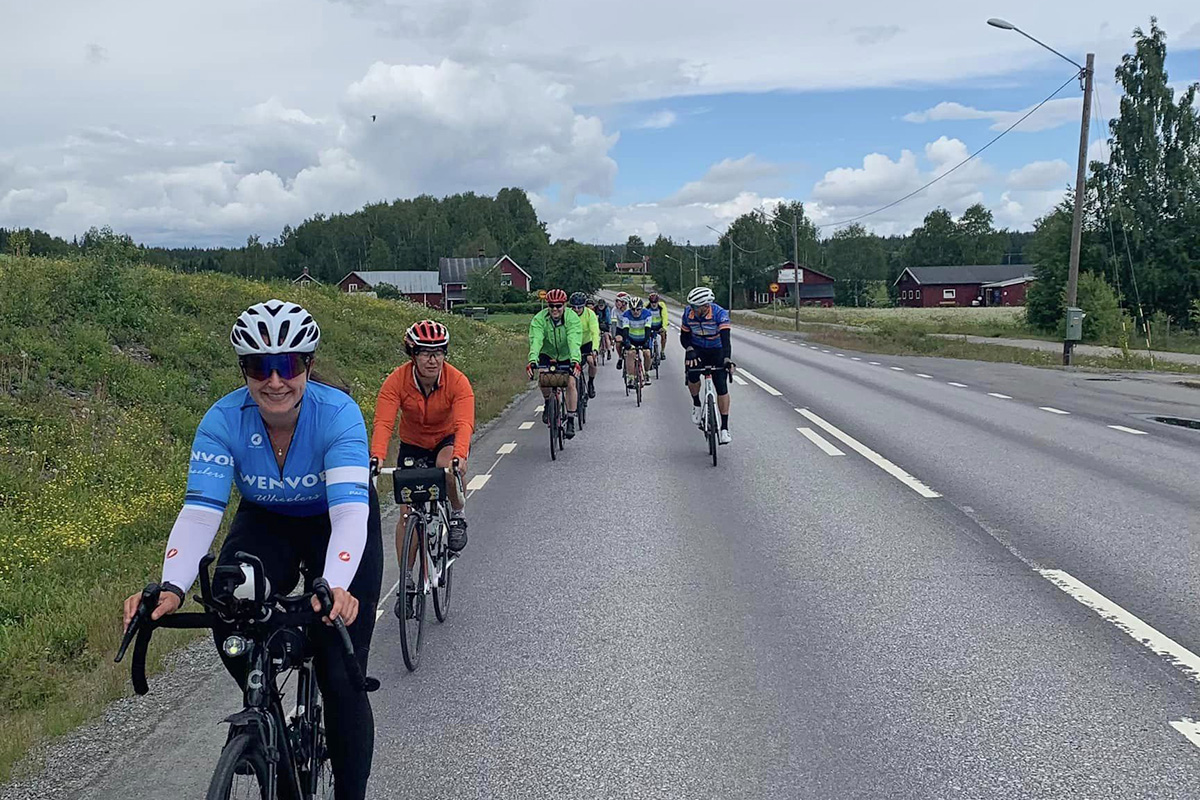
Well, OK then. There was a group cry of shit/sheisse/lort/merde/etc as we wondered whether we’d be trapped in the campground waiting for the storm to pass. Brook didn’t care, heading out alone almost as soon as we arrived—no Epic Ride Weather for you today, only death. There wasn’t enough signal to try to get a forecast. The Danes went to confer with their support van, and I hung out for a bit inside one of the red cabins. It was cozy and warm inside, and only the thought of being left behind by the wagon-train lured me back out into the rain.
The Danish support claimed that it was warm and sunny in Umea. All we had to do, they promised, was pass south through the band of sheisse-lort that was heading east, and we would emerge into blue skies. They gave us muesli bars and cookies, too, so who could question their good will?
Some lovely volunteers were offering the riders a local dish, called Palt, over in a pavilion. Deep fried pork dumplings would no doubt be delicious on a Polar expedition, but it wasn’t exactly riding food. Some brave riders tried it with lingonberry jam. Descriptions in several European languages didn’t reassure me (“mit Schweinfleish”!—nothing like German to make your food sound appealing).
After the Danes had changed their clothes and outfitted themselves with fresh raingear—looked like Shakedry—we were off again. There were some rolling hills and a patch of heavy rain, but not enough to soak us before it quickly petered out into patchy clouds and sun. The support crew was right! The lort was moving quickly off to the east and we were now headed for a patch of blue sky.
The course rolled but overall trended downhill, from about 700 feet down to sea level. We went along the Vindeläven river for quite some time, then past Lake Tavelsjön, with boaters out having fun in the suddenly remarkable sunshine.
There was a big downhill, then we turned off the main road onto the smaller roads that had been part of the coffee ride 3 days earlier. Now we all knew where we were and were smelling the barn, not bothering to change our clothes as a heavy rainshower started. The shower was accompanied by a massive, blustery tailwind, so we barely had to pedal as we sailed into the outskirts of Umea. Although it was rush hour, we stayed mostly on bike paths and small side streets and encountered very little traffic. The last landmark was a sign that I was convinced read “DUCKBITES 395 kr”, but we didn’t stop for duckbites and were soon waiting at the last traffic light of the ride, with the sign for SCANDIC PLAZA peeking out ahead.
Lots of volunteers greeted us at the finish, stamped our cards, checked us in, and opened the storage room so we could get our clean clothes. Everyone dispersed immediately, desperate to remove our wet lycra and shoes. Just as I came out of the shower and climbed into bed to rest, a peal of thunder shook the hotel and I wished good luck to all of the riders still out there on the course.
Jay Nadeau
Stats
Finish time: 66:12
Average speed: 18.3 kph
Sleep: about 8 hours in a total of 4 times (370 km, 564 km, 754 km, 949 km)
Showers: 5 (the above plus at 859 km)
Loads of laundry: 1
Sauna: 2 (859 and 949 km)
Alexander Westphal
Tuesday, 18 June 2024, 02:10 a.m., somewhere between Hattfjelldal and Mo i Rana in Norway:
Silence… …
Next to the road, there is a lake, not a ripple disturbing its smooth surface. On the horizon, some mountains with leftover snowfields. A couple of clouds block the sun that is still/already up. I dare not to breathe lest not to disturb the silence. The last person I met was one hour ago shortly after I left the Hattfjelldal Hotel. The next person will be a car on the E6, still some three hours away.
A single birds calls out – a sign to continue… When people ask me why these long rides? The stretch between Hattfjelldal and Mo i Rana provides all the answers I can give.
From London City Airport in 2021 to the starting line in Umeå in 2024
06 December 2021: I am in London City Airport waiting for a delayed flight home, trying to figure out my 2022 calendar. Mile Faílte 1 200 in Ireland is tentatively scheduled for Summer 2022, maybe it’s on, maybe it‘s not. I stumble across the info for the inaugural edition of MSR, briefly check our family calendar (with the Mile Faílte already penciled in) and register instead for MSR 2022. Done. Then, in Q1 2022, the ride in Ireland is finally on, so I defer MSR to a later year, i.e. 2024 as the 2023 edition conflicts with a Paris Brest Paris qualification ride. Over the next two years, I pick up two fellow riders from Germany, Ben Urbanke and Michael Patzer who do not need convincing to participate.
On a Wednesday afternoon in June 2024, I leave my Berlin office to meet Ben and Michael north of Berlin, all three of us and our bikes spread across a van. The overnight ferry to Sweden is packed with Vätternrundan participants (same weekend), but we are in for a slightly longer ride. A very long day of driving ends in a small hut on the Umeå campground.
It’s eleven p.m. and there’s still ambient light outside. Friday and Saturday are spent riding around Umeå, getting the bikes tuned up (shoutout to Umeå Cykelsport for adjusting Ben’s drivetrain) and generally getting ready to fight mosquitos and wondering what to pack and what to leave. In the end, I decide on extra set of thermal underwear (which I carry around unused for 1 213 km) and only four energy gels (of which I should have packed more). Josef Bäurle and Johannes Markofsky (with his recumbent bike) join us, having taking a flight to Stockholm and then the overnight train to Umeå.
On Sunday afternoon, four hours of sleep before we set off to the starting point to have dinner. Brilliant idea to have the attic of a old manor converted into luxury audax pre-ride-sleeping-facilities by Florian and his crew of volunteers. Lots of gawking at other bikes, lots of bits and pieces overheard from the neighboring tables (”Yes, the McDonald’s in Dreux is open until 11:00 p.m. and only slighty off route”); not sure what a normal person would think if presented with this tableau of middle aged individuals at 10:00 p.m. just outside Umeå.
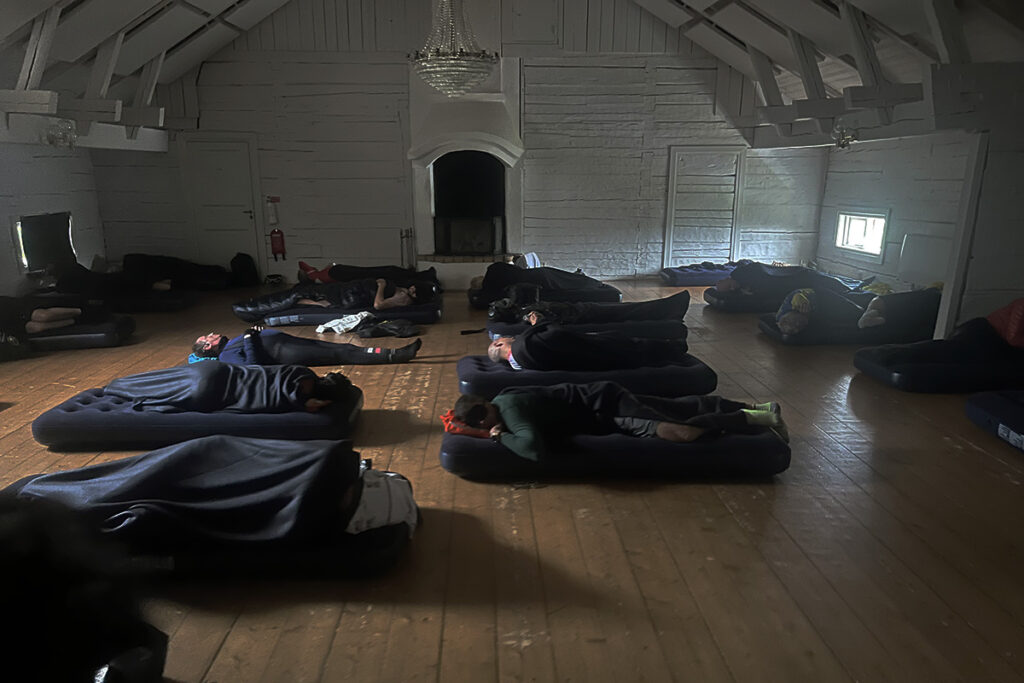
At 23:05 on Sunday 16 June 2024, 91 participants depart Umeå westbound, quite leisurely. No rush here. As for a plan, I will stick with 500:400:300 with decent breaks for sleep in between. That plan works well for me. The four of us ride together (Johannes with his recumbent bike choses his own pace), changing lead with a group from Denmark. It’s a fast pace, in line with the good road, lack of hills, lack of rain and warm (11 – 15 degrees Celsius) temperatures. Forests, lakes, rivers – that’s the vista as the first 240 km to Vilhelmina are ticked off in just over nine hours – it’s 08:00 a.m., brief breakfast at a hotel (included – as are all meals – in the very very reasonable starting fee).
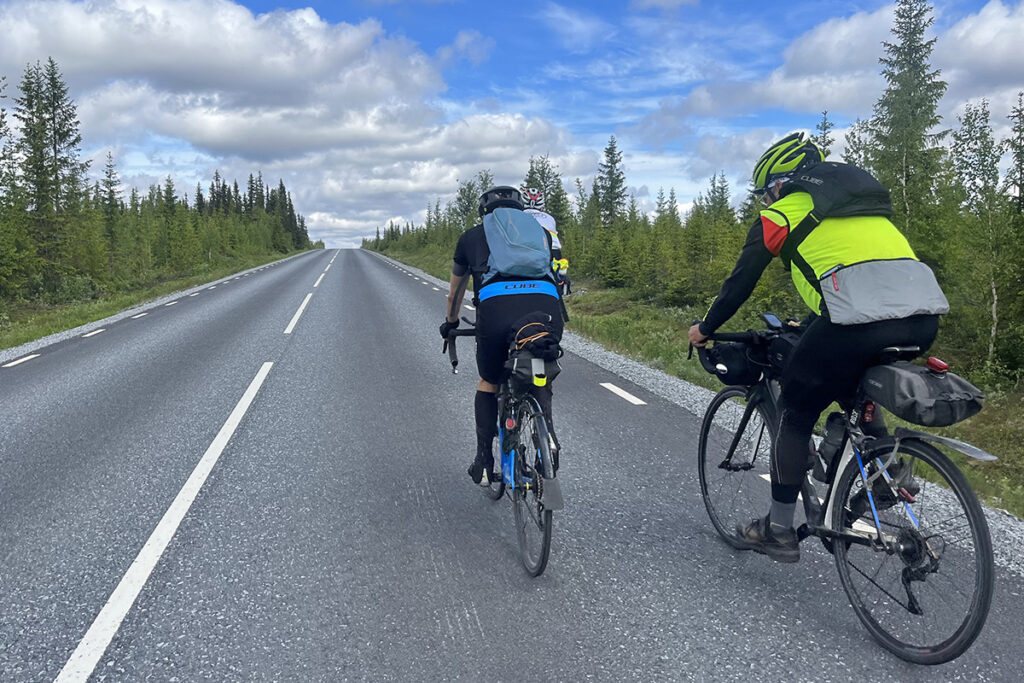
Off to Kittelfjäll at 370 km with pasta lunch, and then all of sudden, rolling hills start to appear. Rolling hillls, nasty little buggers. No nice descents either, as the excellent Swedish roads give way to lesser grade road surface in Norway. Two brief but soaking showers before we hit Hattfjelldal at 468 km on Monday 18:09 after 19 hours on the road. Seafood chowder for dinner, not as nice a place as the other stops, but there just isn’t much around, period, in these parts of Europe. I had pre-booked a room with a real bed and retire for six hours of sleep. The other three decide to keep going to Mo i Rana (and getting soaked in the process).
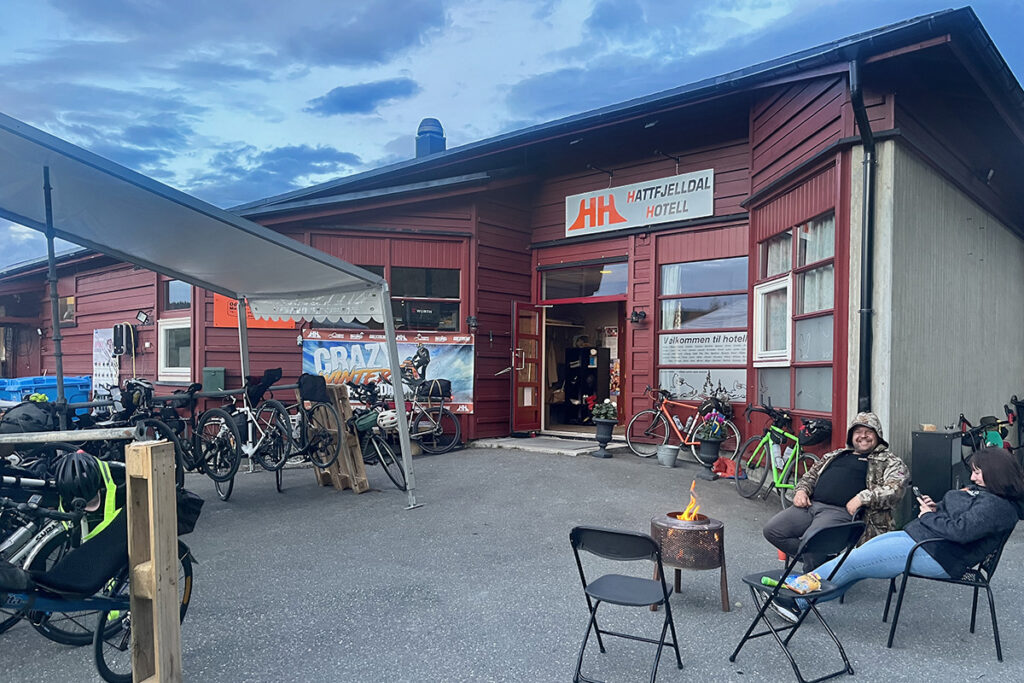
Stepping out of the Hattfjelldal Hotel at just past 01:00 a.m. on Monday, I bid goodbye to the manager and his partner sitting around fire with about 30 bikes leaning this way and that. What a sight. I descent to the main road and try to start find a rhythm, only to be rudely reminded by my Wahoo that the following section to Mo i Rana has something like 23 climbs over 100 km or so.
The track – still damp from the earlier showers – follows the main road for about twenty seconds before rolling hills starts. I pass one fellow cyclist and then ride the next four hours by myself. There is nobody out here. No car, no cyclist, no camper with a German or Dutch registration. Nothing but silence. I curse myself for breathing loudly.


There are only a few cars once the track turns north on the E6, supposedly quite busy, at 05:00 a.m. in the morning. The ride to the Yttervik campground, the next control, just before Mo i Rana, is thus splendid. Flat, a fjord to the left and waterfalls to the right. At 05:37 a.m., it’s the Yttervik campground with a local volunteer already up and force feeding me bananas and Coke. Michael is already up and running, but the others are still asleep, so I continue alone. In Mo i Rana proper, the sun crests from behind the mountains. 7/11 provides a welcome stop, change to short/short, chat with my wife and the kids… 45 minutes and a lot of chocolate croissants later, I start up the long ascent to the Arctic Circle (from sea level to 700 odd meters). Half way up, a phone call by the side of the road turns into a 30 minute power nap at a bus stop in the sun. I hear first Josef, then the others passing by. By the time I have myself sorted, the four guys from Denmark (shoutout to Thomas and Stig!) are just passing. I join them up the hill, now mingling with camper vans and trucks on the E6.
Generally respectful motorists, except camper vans with German registration. Arctic Circle at noon at 661 km: The sun is out, tons of photos, quick lunch and then I join Ben, Michael and Josef again for return to Umeå. Rather, three of us follow Josef whose impeccable style and use of a triathlon bike allows us to regularly exceed speeds otherwise reserved for alpine descents. Flattening out on the last bit of E6 just before the Kjernfjell tunnel, we turn right again heading east back towards Umeå. Question though: where? Through the tunnel (as Garmin with the complete 1 213 km track suggests) or over the hill (as Wahoo with the individual segments loudly proclaims)? We decide to go over the hill, adding some 200 m in elevation and spectacular views.
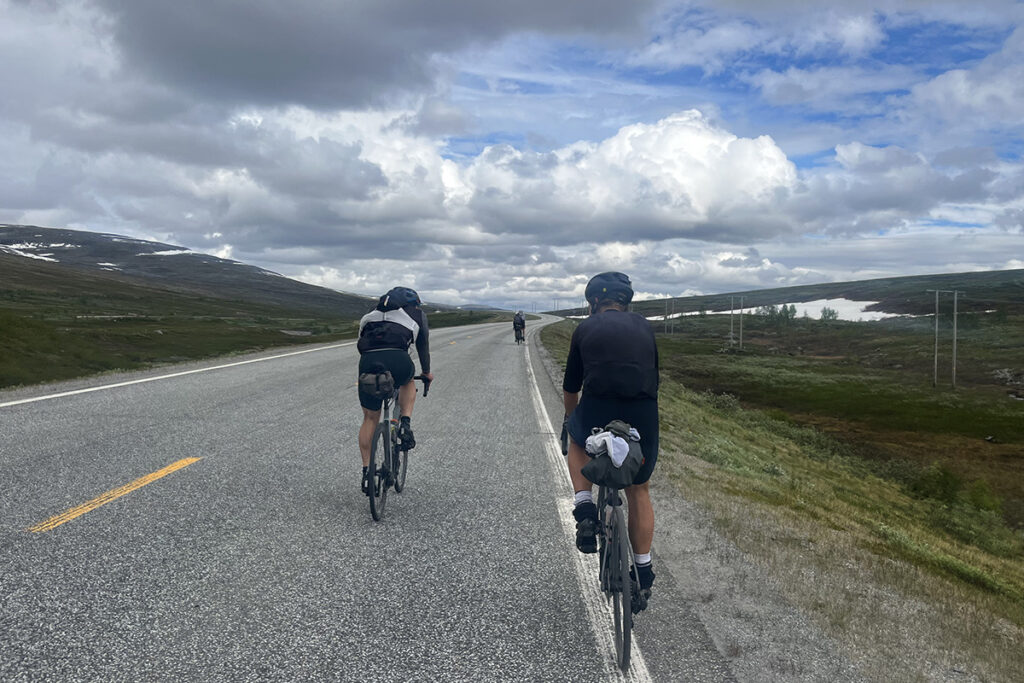
In addition to serving as a control for MSR, the very luxurious camping ground at Vuoggatjålme at 754 km must be the local headquarters of the United Mosqitoes Of Scandinavia. Or so it feels as we come to a stop at 16:30 on Monday. I do not recall the food, which means it was neither very good nor very bad. But the self-baked energy bars in cookie format… brilliant! On the next 105 km to Arjeplog (859 km), now on flattish terrain, we pick up a) one rider from the US (Jay Nadeau), and b) a thunderstorm with 10 km to the control.
The hotel staff in Arjeplog could not have been more forthcoming in welcoming five riders soaked to the skin, running around in undergarments getting their clothes to the dryer. They had a beer and noodle salad, too, before their bar closed at 22:00. The Danes show up, dry off and proclaim that they’ll leave after a single hour of sleep in order to beat a ”band of rain“ between the next stop and the finish. Having prepaid a room with a bed at the hotel, I shrug them off for another six hours of sleep.
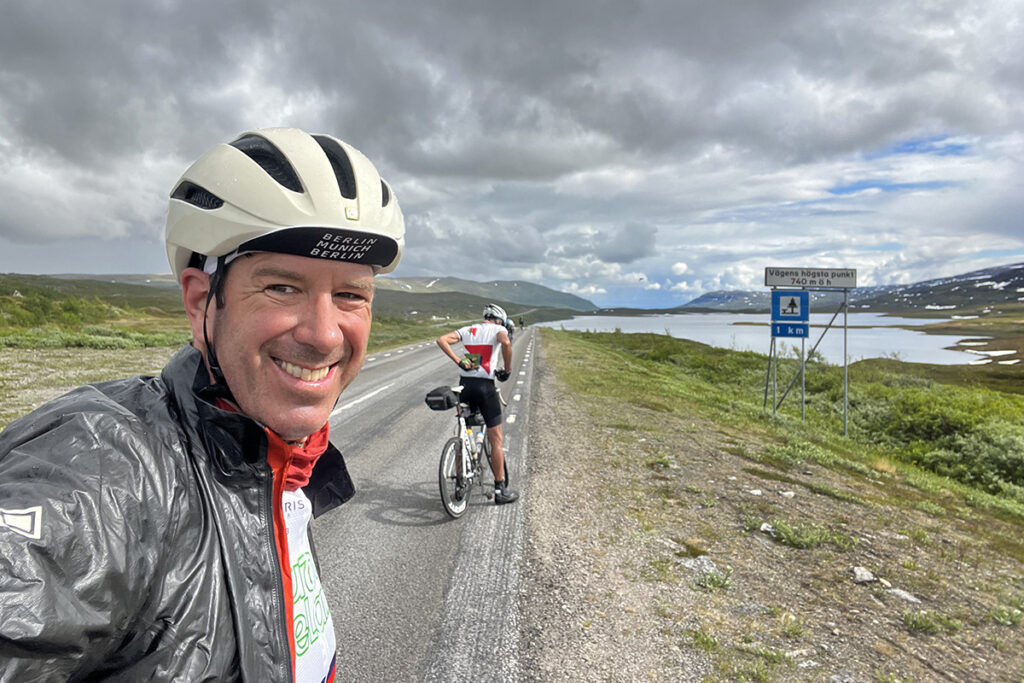
Wednesday morning 06:00 a.m. (luxurious hotel buffet) breakfast in Arjeplog, 354 km to go to Umeå. So Pizza dinner in Umeå by 19:00, right? Or so we thought. 10 km before the next control in Sorsele, the skies open up. As in: you may as well leave your rain gear stored in the Tailfin, it wouldn’t have mattered anyway. A hotel in Sorsele, after 949 km at 10:43 a.m. We hang around, watching the parking lot becoming a lake. Hot lasagna. Coke, bananas, the works, right? Sorsele has one more surprise: A sauna with a view of adjoining lake. The sauna is used to dry randonneur clothing and reheat riders. An interesting olfactory mixture, but WHAT A TREAT! After the sauna, two hours nap on sleeping pads in a warm, dry and comfy conference room. Heaven! By the time the ”band of rain” has passed through Sorsele and the road to Umeå, it’s 16:42. I have slept roughly eight hours over the last 24 h, bliss!
Fully rested with dry clothes, it’s a sprint for the last 264 km back to Umeå. The four of us pass a number of riders who had set out from Sorsele while it was still pouring rain. One secret control by the side of the road, another one at a campground in Åmsele at 1 107 km. By the time we hit that last control, it’s 21:51, very windy (tailwind!) and the temperature has dropped to eight degrees. The food was cooked over an outdoor open fire, which probably would have been rather romantic on any other day, but I start to shiver from the wind. I gobble down a second helping and leave shivering from the cold. The other catch up 15 km down the road.
As we travel southeast towards Umeå, the sunset/-rise sort of sneaks towards the left (north) of us… utter confusion in terms of my sense of direction. Other than us, there are only moose, mosquitos and views of the Ume River, on the 354 km between Arjeplog and Umeå. A couple of rolling hills on the last 30 km, and we enter the final control, a hotel in Umeå on Thursday at 02:19 a.m., after 75 h on the road.
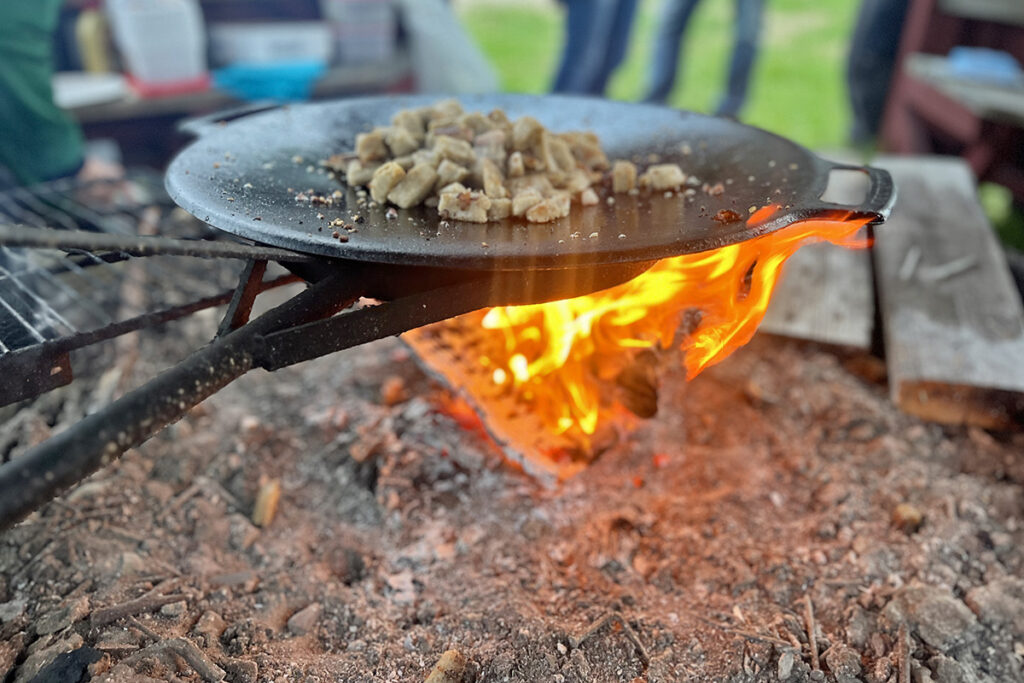
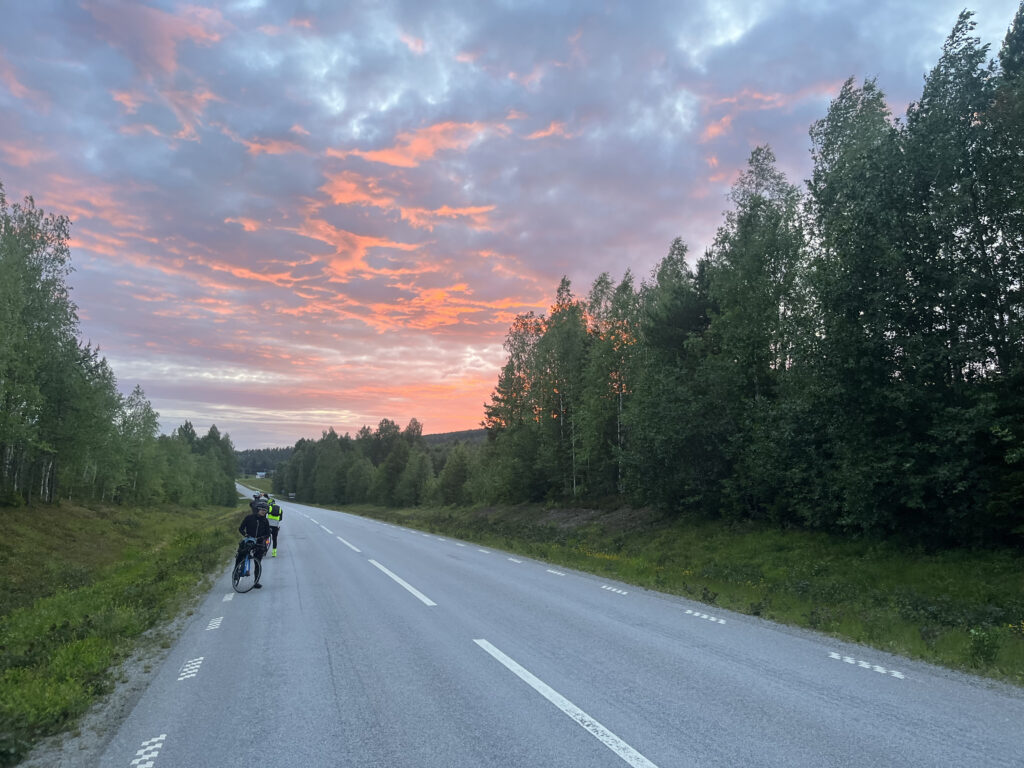
By the time we wolf down the cold chicken salad and retire to a hotel room, it’s coming up to 03:00 a.m. Thursday morning and sun is already 10 degrees above the horizon.
Thursday morning, we do not leave a single breadcrumb on the hotel buffet (”yes, we will still eat the rest of oatmeal, no need to clear it now”). If there is ever full feature movie on a 1 200 randonneuring event, the opening sequence should feature the faces of the hotel staff wondering how much breakfast two riders can scarf down in 45 minutes. Spend some more time welcoming other riders to the finish before a 10 km ride back to the campground for some more food, bike sorting and sleep.
Friday morning, brief Uber ride to the airport and back to Berlin via Stockholm (I had booked a cheap non-refundable one way prior to Ben and Michael joining me on the MSR) on Midsommar 2024. The others travel back by van to Rostock, where Josef parts ways with them and rides his bike back to his home in southern Germany, another 700 km or so.
Final shoutout to Martin Spreemann who left Berlin on the morning of the start: His bike made it with him to Umeå, but all his other equipment did not. He started twelve hours behind everybody else on Monday morning, only to make it back to Umeå by Thursday evening just after cutoff. And back to Berlin by Friday.
Alexander Westphal (Ride on Strava)
Stats
10 day trip, 1 218 km in 75:14 h (thereof moving 44:34 h), 9 621 m elevation. Two paid nights in hotel rooms during the ride, one paid hotel room after the ride, other nights on ferry/campground. Generally dry with four showers, thereof one thunderstorm and one six hour band of heavy rain. Temperatures between four degrees and 17 degrees Celsius. 2021 Kocmo Titanium Randonneur, Aerobars, Tailfin, two Gramm candy bags, 32 mm Continental GP 4Seasons, SRAM Force eTap AXS, Lupine Piko (went unused except for three minutes in a tunnel), Garmin Varia Radar (always on), Garmin 1040 and Wahoo Elemnt Roam, Powerbank, two change of clothes + extra rain gloves. No mechanical/bodily defects. 50+ killed moquitos. Brilliant volunteers (hanging out by the side of the road, in the middle of nowhere, with nobody for company except five million mosquitoes and maybe five or six cyclist every hour… kudos and thank you!).